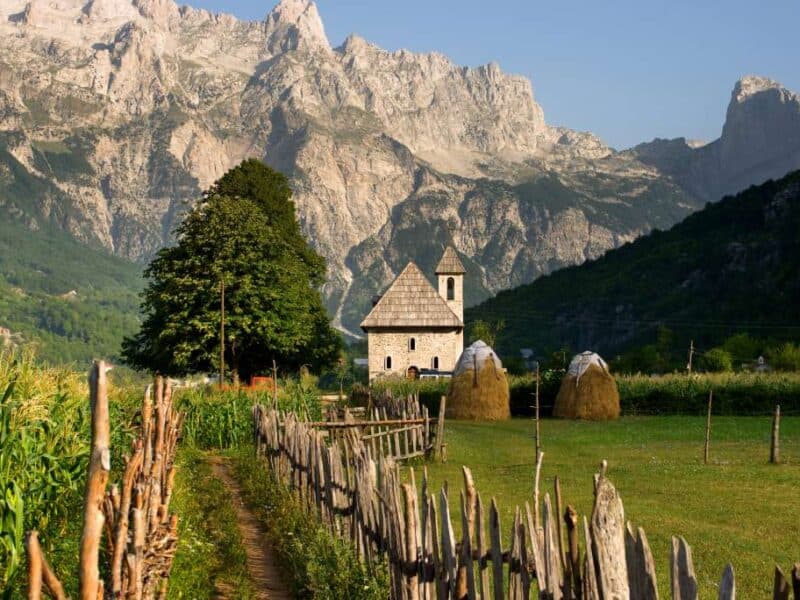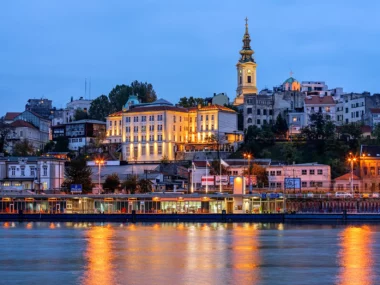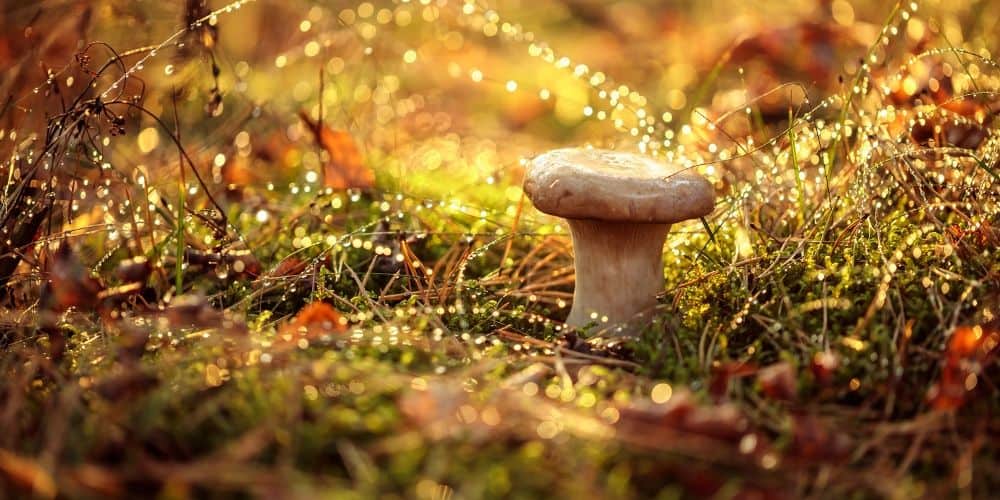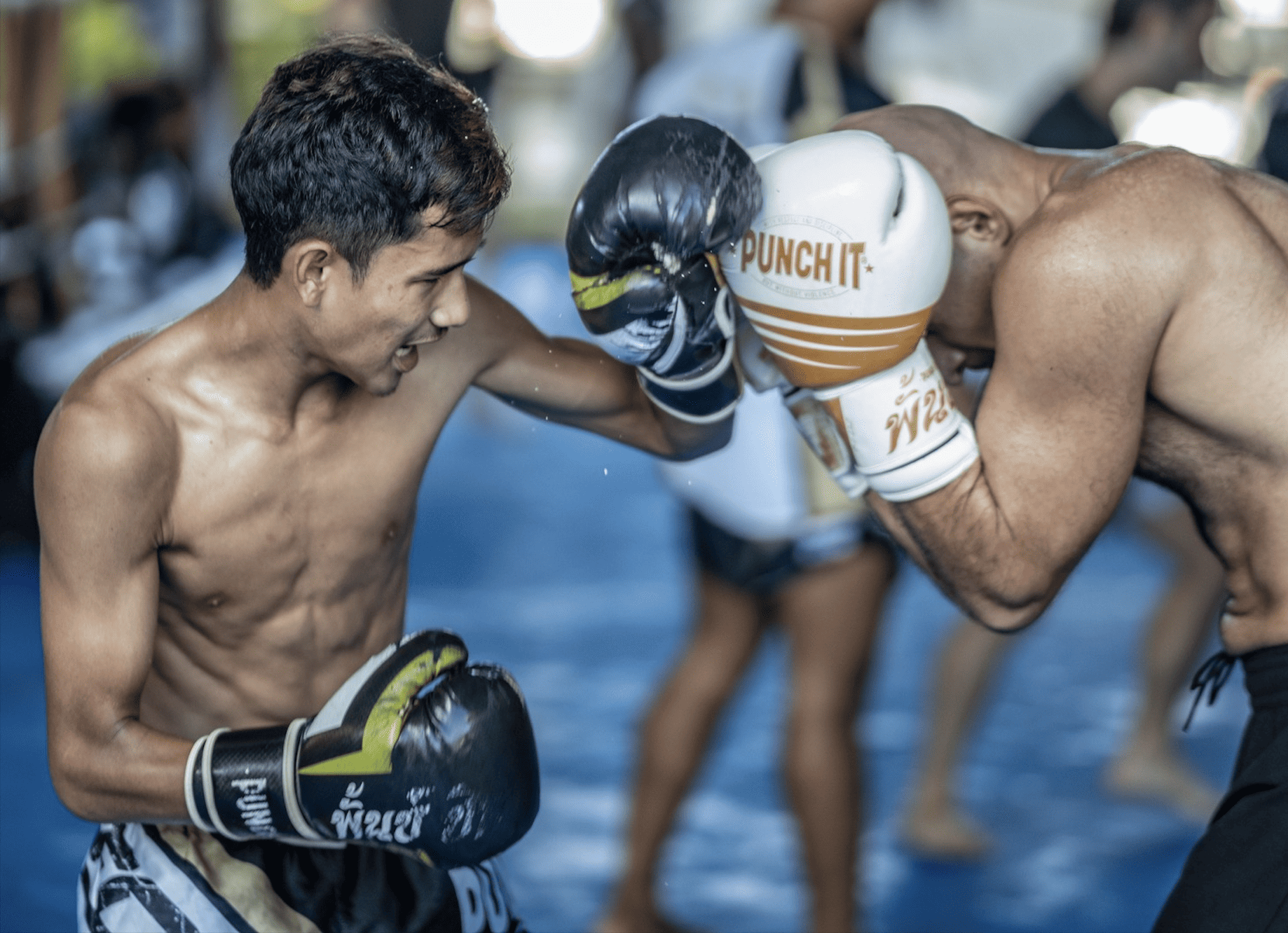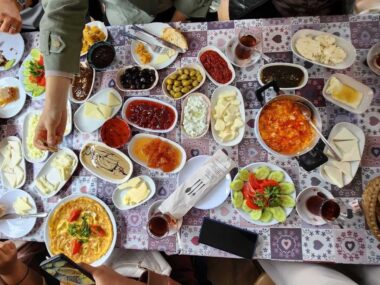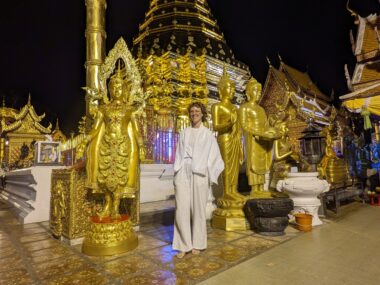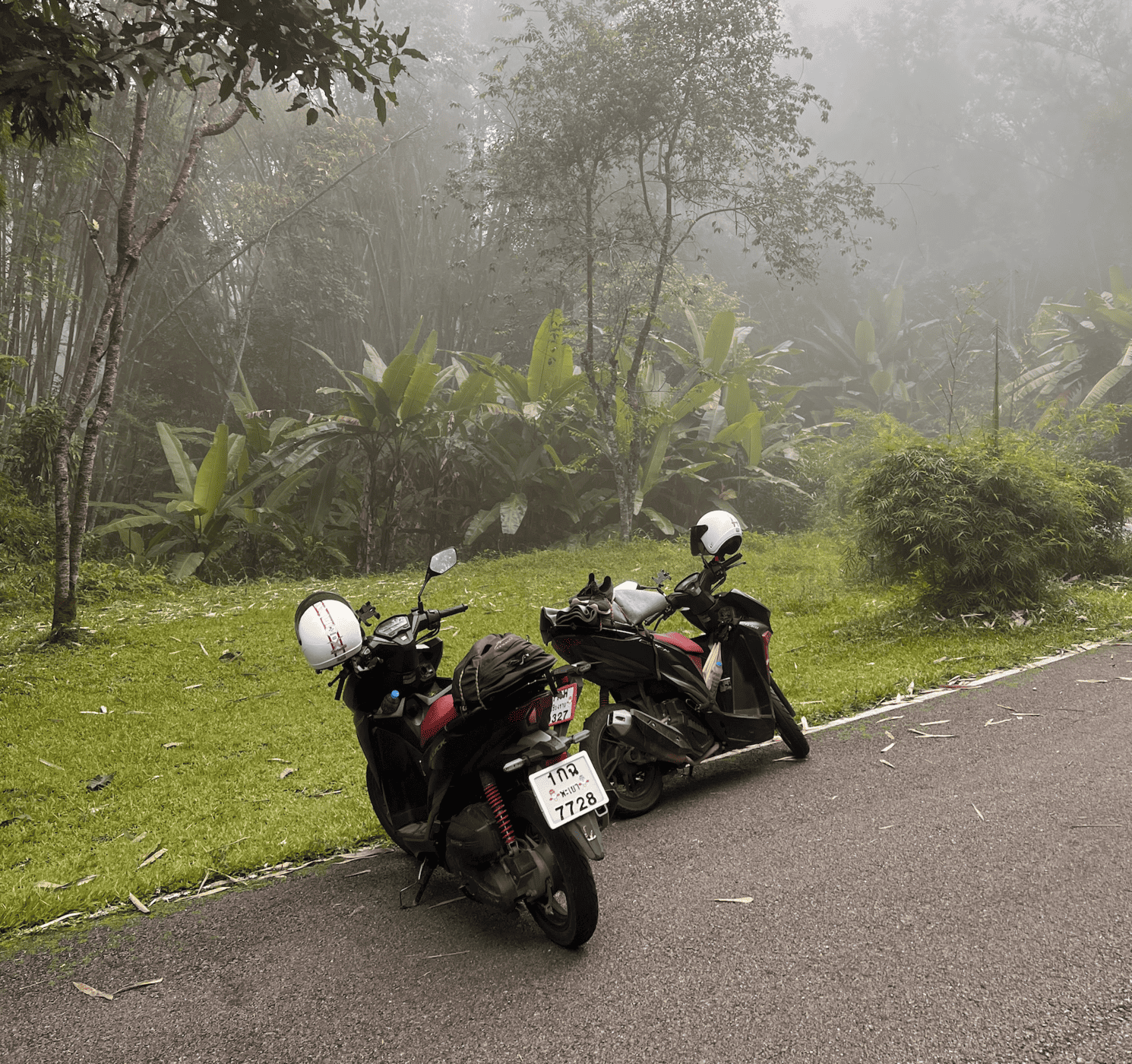Table of Contents
The Beautiful Balkan Country
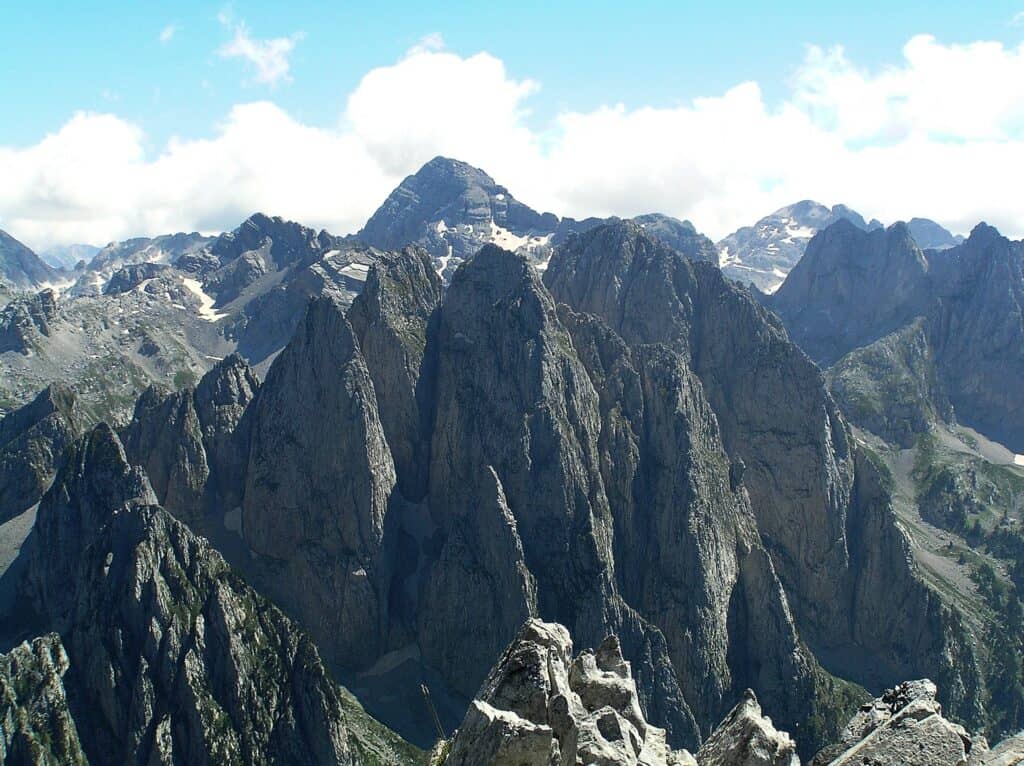
Alright, let’s dive into Albania. It’s this Balkan country you might not have heard much about, but trust me, it’s starting to get noticed. There’s a lot to love: striking landscapes, a deep-rooted history, and locals who are genuinely glad to see you. From the bustling city life of Tirana, to small coastal towns along the Adriatic Sea, to the rugged wildness of the Albanian Alps, you’ve got a ton to explore.
But we’re here to do more than just paint a pretty picture. We’re going to dig into the practical stuff too – safety, transportation, and cost of living. The stuff you need to know before you book your flight.
Plus, to truly appreciate a place, you need to understand its history, right? We’ll cover some major historical events in Albania so you’re well-prepared for your backpacking trip.
First up, Tirana. The capital of Albania, and it’s a lively place full of charm. Then you’ve got the calm Adriatic coastline, dotted with picture-perfect towns, offering a blend of history and killer views. And don’t miss the Albanian Alps – raw, untamed, and stunningly beautiful.
We’ll also talk about safety, ways to get around, and what you can expect to spend day-to-day. The real stuff, the practical details to help you plan your trip to Albania.
Why Albania?
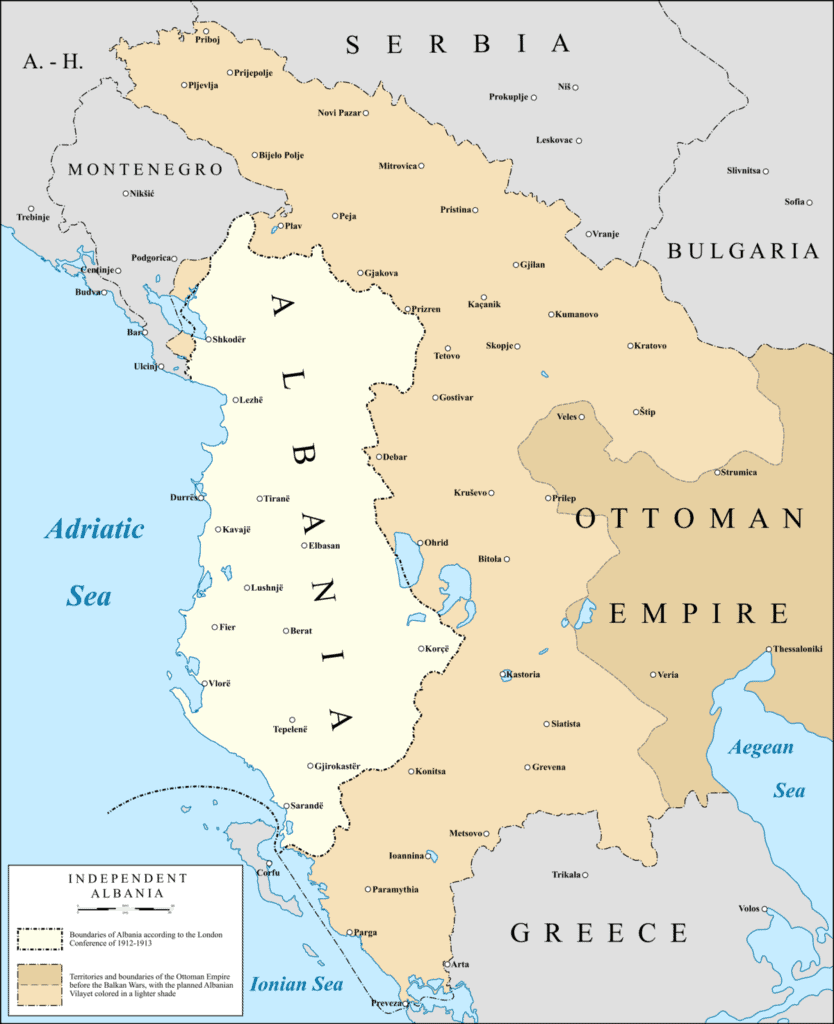
Now, you might be wondering – why pick backpacking in Albania for my next trip? To put it simply, backpacking in Albania offers the authentic, uncrowded travel experience that seasoned wanderers seek.
The country is a playground for diverse interests. If you’re a fan of the great outdoors, hiking through the rugged paths in the Accursed Mountains or strolling along the pristine beaches of the Albanian Riviera will leave you mesmerized. For history enthusiasts, cities like Gjirokastër, a UNESCO World Heritage site, offer an immersive journey back in time with their well-preserved Ottoman-era architecture.
Above all, it’s the genuine warmth and hospitality of the Albanian people that sets this place apart. Whether you’re navigating the bustling streets of Tirana or the narrow alleys of a quaint village, you’ll always encounter a friendly face ready to assist or simply share a tale or two. As a solo traveler, it makes the journey far more enriching.
History of Albania
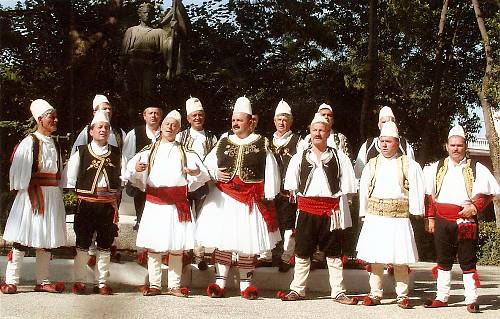
Way Back When – Ancient Times to Middle Ages
Albania’s had quite a colorful past, with different crews taking turns at the helm. Starting with the original residents, the Illyrians, the country went on to play host to the Romans, Byzantines, and the Ottomans. Each group added their own flavor to Albania’s mix, which you can still catch a whiff of today in its culture and architecture.
Ottoman Era (15th Century – 1912)
In the 15th century, the Ottomans rolled in and decided to stick around for almost four centuries. They left a strong impression, especially on the religious front, with most Albanians picking up Islam. You can spot the Ottoman touch in the form of mosques and unique architectural styles, particularly in towns like Berat and Gjirokastër.
Independence and World Wars (1912 -1944)
1912 was a big year for Albania as it broke free from the Ottoman Empire. Things got pretty messy during the World Wars, with Italy crashing the party during World War II. However, the Albanians managed to boot them out by 1944.
The Communist Chapter (1944 -1992)
After World War II, the story took a sharp turn with Enver Hoxha coming into power and steering Albania down the communist route. Hoxha was big on isolation, cutting off ties with the rest of the world, and let’s just say, personal freedoms weren’t exactly his thing. The heaps of concrete bunkers littering the country are a stark reminder of his obsession with potential invasions.
Post-Communist Era (1992 – Now)
The early ’90s saw the fall of communism, and Albania was finally able to come up for some air. It’s been a journey of transformation since then, with major upgrades in the country’s infrastructure, economy, and a thriving tourism scene. Despite all the changes, Albania has managed to keep a firm grip on its rich traditions and cultural roots.
Knowing these bits about Albania’s past will definitely add an extra layer of appreciation to your travels. From the cool architecture and tasty food to local customs and stories, you’ll see the country through a more informed lens. Enjoy the ride!
Pre-Travel Preparations
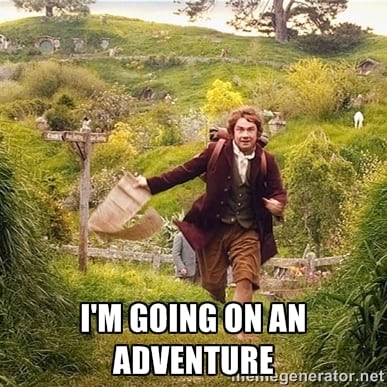
Every country is unique, and so is the approach to preparing for a visit. Here’s how you can tailor your pre-travel preparations specifically for your journey backpacking in Albania:
Passport Check:
Always ensure your passport is valid for at least six months beyond your planned departure date. In Albania, this rule is strictly observed. Additionally, if you’re planning to travel to neighboring countries like Greece or Montenegro, this same rule applies. Also, don’t forget to keep a digital and physical photocopy of your passport; it’s a common requirement to provide passport details when checking into Albanian hotels.
Visa Status:
Albania typically offers visa-free entry for up to 90 days for citizens of many countries, but it’s always essential to check the specifics for your nationality. Check with your local Albanian embassy or consulate, or their official websites for the most accurate information. While you’re confirming, also check the entry requirements if you’re traveling through other countries to reach Albania.
Health Checks and Vaccinations:
Although there are no specific vaccination requirements for backpacking in Albania, it’s always good to be up-to-date on routine vaccines. Note that Albania has a Mediterranean climate with hot summers and mild winters, which can influence the prevalence of certain diseases. As healthcare services may not be as accessible in rural areas, it’s advisable to pack a comprehensive first-aid kit.
It’s advisable to be up to date on routine vaccines like
– MMR
– diphtheria-tetanus-pertussis
– varicella, polio
– and your yearly flu shot.
Check with your healthcare provider for personalized advice. And remember, pack enough of your prescription medicines – sometimes finding specific medication in a foreign country can be challenging.
Travel Insurance:
Comprehensive travel insurance is a must, as medical costs can be expensive for foreigners in Albania if there is an emergency. Make sure your insurance covers emergency transportation costs, as Albania’s mountainous terrain and underdeveloped rural road networks outside of the major cities can make access to medical facilities challenging.
Whether it’s an unexpected illness, a sudden trip cancellation, or lost luggage, travel insurance can cushion the financial blow. Opt for comprehensive coverage, including health, theft, loss, and trip interruption. If you’re planning to indulge in adventure activities, ensure they’re covered in your policy. For information on traveling solo and getting good insurance, check out our Nomad’s Travel Insurance guide!
Brush Up on the Local Lingo:
English works well in Albania, especially among the young crowd and in the tourist hubs. But where’s the fun in traveling if you don’t pick up a bit of the local language? DuoLingo can help you learn some basic Albanian phrases such as:
– ‘Përshëndetje’ (Hello)
– ‘Faleminderit’ (Thank you)
– ‘Po’ (Yes) and ‘Jo’ (No)
– A flisni anglisht? (Do you speak English?)
It’s a small gesture, but it can enrich your interaction with the locals and can be quite handy.
How to Get to Albania
Here are some guidelines on how to get to Albania from different parts of the world! Albania has a few airports but there are the major ones:
Tirana International Airport Nënë Tereza (TIA)

Also known as Rinas International Airport, this is the largest and busiest airport in Albania. It’s located near the town of Rinas, 11 km northwest of the capital city, Tirana. The airport offers flights to many destinations in Europe, and it’s the main international gateway to Albania.
Kukës International Airport “Zayed North”
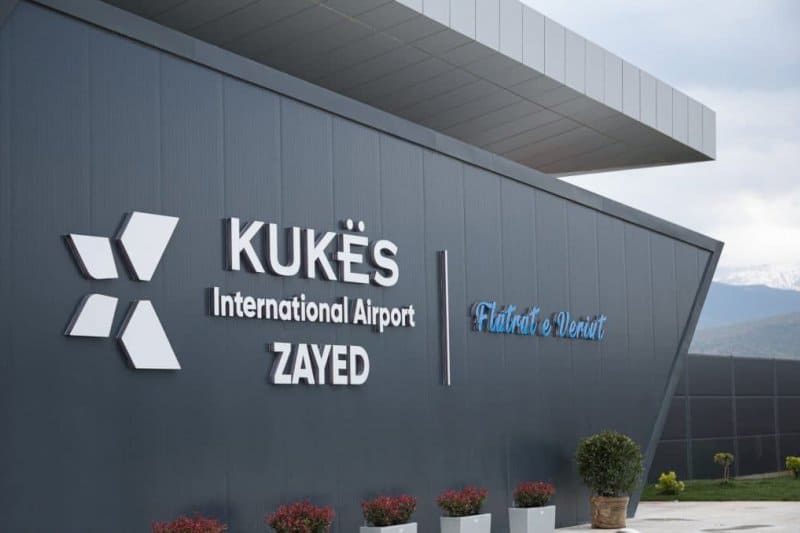
Opened in 2021, this is the newest international airport in Albania. It’s located in the northeastern city of Kukës. Currently, it serves low-cost carriers and it’s expected to boost tourism in the region.
Note: Due to its geographical location, many travelers visiting Albania also fly into neighboring countries’ airports (such as Podgorica in Montenegro or Pristina in Kosovo) and travel overland to Albania. Always check multiple options to find the best itinerary and ticket prices for your trip.
From the United States
If you’re departing from a major U.S. city like New York, Los Angeles, or Chicago, flights to Tirana typically range from $600 to $1,200 depending on the time of year and how far in advance you book. Flights can take anywhere from 12 to 15 hours, including layovers. Airlines like Turkish Airlines, Lufthansa, and Austrian Airlines offer one-stop flights.
Once in Tirana, you can catch a bus to Shkodra for around 500 Albanian lek (about $5USD or Euros), which is about a 2-hour journey. From Shkodra, another bus or taxi will take you to Valbona – this journey may cost about 1,000 – 1,500 lek (roughly $10 – $15USD or Euros) and takes around 3 hours.
From the United Kingdom
Direct flights from London to Tirana take approximately 3 hours and can cost from £90 to £200 depending on the time of year and how far in advance you book. Companies like British Airways offer direct flights.
As with the U.S. route, from Tirana you can take a bus to Shkodra (around $5), and then another to Valbona (about $10 – $15).
From other European cities
If you’re departing from Rome, Vienna, or Istanbul, flight prices can range from €100 to €300, and flight times are approximately 2 hours.
The bus routes from Tirana to Shkodra and then to Valbona are the same as previously mentioned.
From within Albania:
If you’re already in Albania, you can get to Valbona by bus or taxi from any major city. The city of Shkodra is a common starting point for many travelers as it is closer to Valbona. Buses from Shkodra to Valbona run daily and typically cost around 1,000 – 1,500 lek ($10 – $15USD or Euros).
From Montenegro:
From Podgorica, the capital of Montenegro, you can catch a bus to Shkodra. This bus ride takes about 2 hours and costs around €10. Once in Shkodra, you’ll need to take another bus or taxi to Valbona, costing approximately $10 – $15 USD. I caught the bus from Kotor to Shkodra and the costs were minimal and the views along the way were beautiful.
From Kosovo:
From Pristina, the capital of Kosovo, you can take a bus to Prizren, which costs about €4 and takes roughly 2 hours. From there, a bus goes directly to Valbona for around €10 and takes approximately 4 hours.
Remember, these are estimated costs and travel times. It’s always recommended to check for the most recent fares and schedules
Weather in Albania
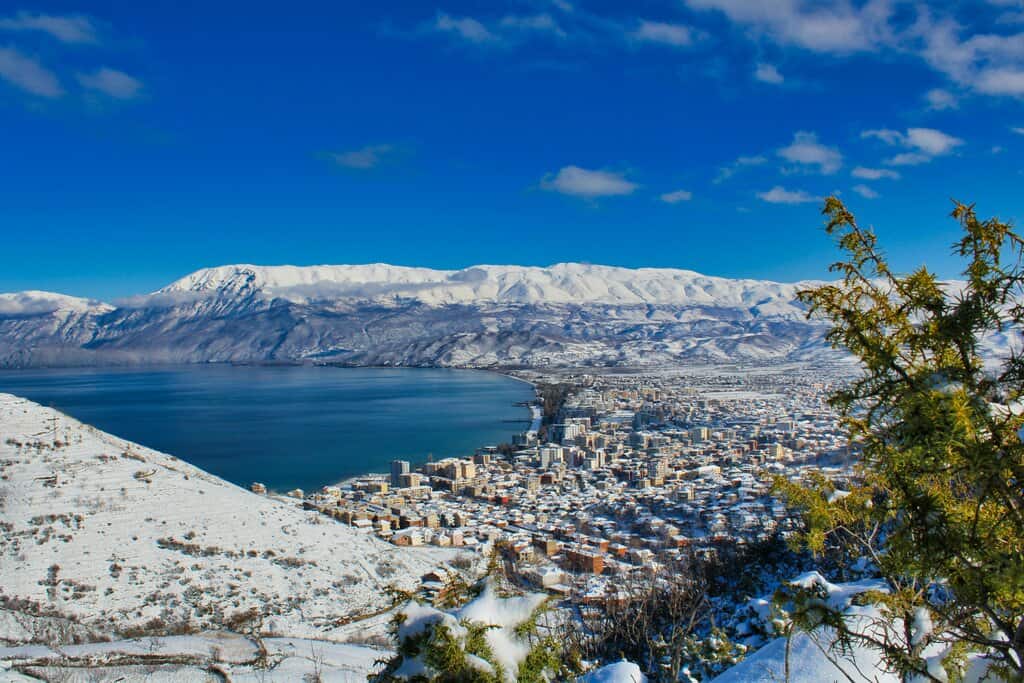
Albania offers a variety of climates due to its diverse geography, which includes coastal regions, flatlands, and high mountain ranges.
Coastal Regions
The coastal regions, which include popular destinations like Saranda, Vlora, and Durrës, experience a typical Mediterranean climate. Summers (June to August) are hot and dry, with temperatures ranging from 25°C (77°F) to 32°C (90°F), making it an excellent time for beach holidays. Winters are mild and wet, with temperatures ranging between 10°C (50°F) and 15°C (59°F).
Inland and Mountainous Regions
In contrast, the inland and mountainous regions, like Tirana, Berat, the Albanian Alps, and Krujë, have a more continental climate. Summers are warm to hot, with temperatures from 22°C (72°F) to 30°C (86°F). Winters can be cold, particularly in the mountains, with temperatures ranging from -2°C (28°F) to 7°C (45°F). Snowfall is common in the Alps during winter.
Best Times to Visit
The best time to visit largely depends on what you want to do.
For a beach holiday along the southern coast, the warm, sunny period from June to August is ideal.
If you plan to hike in the mountains, especially for the famous Valbona to Theth trail, the best time is during the late spring (May-June) and early fall (September-October) when the weather is comfortable, and the trails are free of snow.
If your interests lie in exploring historic sites and cities like Tirana, Berat, and Krujë, spring (April-June) and fall (September-October) are ideal as these periods avoid the peak summer heat.
Things to Look Out For
Summer
So, if you’re considering a backpacking trip through Albania, there are a few things you’ll want to keep in mind. During the summer months, particularly July and August, the coastal regions get pretty packed. Seems like everyone – locals and tourists alike – want their spot under the Albanian sun.
Winter
On the flip side, if you’re thinking of heading to the mountainous areas in the off-peak winter season, you might want to think twice. The heavy snowfall tends to quieten things down, with many places closing or operating with limited services due to fewer visitors.
As for safety – yes, Albania’s generally safe, but it’s still a tourist destination, right? So, don’t let your guard down completely. Keep an eye on your stuff, especially in crowded spots.
But don’t let any of this put you off. Whenever you choose to visit, there’s no doubt that the stunning landscapes and deep history of Albania will make your journey absolutely worth it.
Week 1: Unraveling Tirana
Day 1 to Day 4
Arriving in Tirana, the vibrant capital of Albania, you’ll step into a city that has evolved from a 17th-century Turkish outpost to a colorful, fast-developing metropolis.
Start your journey at Skanderbeg Square, the city’s beating heart. Take in the statue of Skanderbeg, the national hero, and the Ottoman-era architecture of the Et’hem Bey Mosque. Make sure to appreciate the 30,000 multi-colored tiles arranged in traditional Albanian carpet patterns. Roaming the square is free, but expect to pay about 200 lek ($1.75 USD or Euros) to enter the mosque.
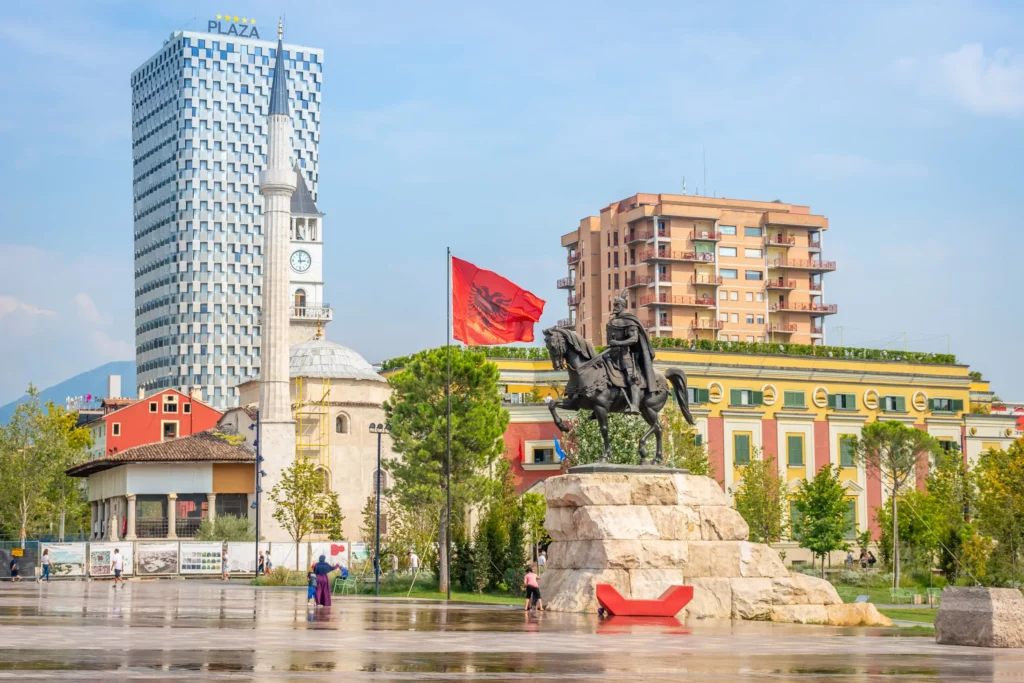
Next, explore the National History Museum, which provides a comprehensive overview of Albania’s history from antiquity to the present day. The entry fee is around 200 lek ($1.75 USD or Euros).
Art enthusiasts should visit the National Gallery of Arts, showcasing Albanian artworks from the 19th and 20th centuries for an entry fee of about 200 lek ($1.75 USD or Euros).
Complete your historical journey at Bunk’Art, a nuclear bunker from the communist era turned into a museum. A powerful testament to Albania’s past, entry will cost you 500 lek ($4.50 USD or Euros).
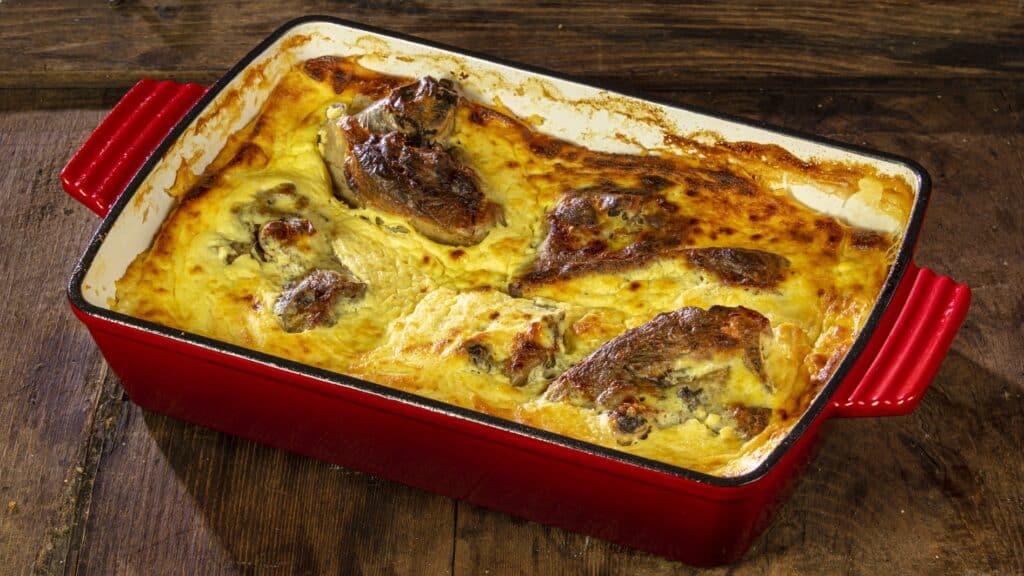
Tirana’s food scene is a delight. Indulge in local dishes like ‘tavë kosi’ and ‘baklava’. Expect to pay between 400-700 lek ($3.50-$6 USD or Euros) for a delicious meal.
Tirana’s nightlife is lively and energetic. Try out Hemingway Bar, known for its creative cocktails, with prices around 500 lek ($4.50 USD or Euros) per drink. I had such a great time there, nothing but good vibes!
Day 5 to Day 7
For the outdoor adventurers, take the Dajti Ekspres Cable Car up to Dajti Mountain for around 800 lek ($7USD or Euros) for a round trip. There you can explore hiking trails, picnic spots, and even try paragliding.
Finally, unwind at the Grand Park of Tirana. It’s free to enter, and you can rent a bike or paddle around the artificial lake.
As for transportation, Tirana is a walkable city. Public buses and taxis are readily available for longer journeys, with taxi rides generally affordable, especially for short distances within the city center.
After immersing yourself in the vibrancy of Tirana, with its rich history, arts, food, and outdoor activities, you’ll be well-prepared to embark on the rest of your journey across this fascinating country.
Week 2: The Southern Coast
Day 8 to Day 14
Upon departing from Tirana, the second leg of your journey escorts you to the southern coast of Albania, where the captivating towns of Saranda and Vlora await. Known for their stunning beaches, rich historical sites, and outdoor adventures, this portion of the Albanian Riviera is sure to enchant you.
Saranda:

Saranda is a picturesque seaside town at the southernmost edge of the country. Also known as,”Pearl of the Balkans” because of its bright blue waters and beautiful beaches. Mirror Beach is a must-visit for sunbathing and relaxing. While you can bask in the sun for free, a sunbed will cost you around 500 lek ($4.50 USD or Euros). The town’s seafront is perfect for evening strolls, lined with cafes and restaurants offering delicious seafood – expect to pay around 1500 lek ($13 USD or Euros) for a meal.
Just a short trip away from Saranda, the ancient city of Butrint is a treasure trove of history. As a UNESCO World Heritage Site, Butrint is home to well-preserved Roman ruins, including a theatre, baths, and basilica, all set within a lush natural park. The park’s entrance fee is around 700 lek ($6 USD or Euros ), and guided tours are available for a deeper dive into the area’s history.
Vlora

Traveling north, you’ll encounter Vlora, a city where the sea meets the mountains. The city’s massive beach is an ideal spot for relaxation or swimming. Pay a visit to the Independence Monument, which commemorates Albania’s declaration of independence in 1912 – entry to the museum is about 200 lek ($1.75 USD or Euros). For some good eats, consider trying ‘çorba,’ a local fish soup, at one of the seafront restaurants – a meal usually costs between 700-1000 lek ($6-$9 USD or Euros).
In addition to its beautiful beaches, Vlora serves as the gateway to the Llogara National Park. For outdoor enthusiasts, this is the perfect place for hiking, bird-watching, or even paragliding. Entry to the park is free, but for a more informative experience, consider hiring a guide at around 4000-5000 lek ($35-$44 USD or Euros). The park is also home to a range of accommodation options, including camping sites and mountain lodges.
Gjirokaster

If time permits, a side trip to the historical city of Gjirokaster is well worth it. Famed as the ‘City of Stone,’ Gjirokaster’s unique Ottoman-era architecture and hilltop fortress offer a fascinating peek into the past. The fortress’s entry fee is 200 lek ($1.75 USD or Euros), and provides stunning panoramic views of the city and the surrounding valley. While there, be sure to check out the Ethnographic Museum, former home of Albanian dictator Enver Hoxha, to get a glimpse of traditional Albanian life. The entrance fee is 200 lek ($1.75).
When it comes to transportation, Saranda and Vlora are well-connected by buses and furgons (minibuses). The journey from Saranda to Vlora by bus will cost about 1000 lek ($9 USD or Euros), and the travel time is approximately 4-5 hours. Furgons offer a more flexible schedule but tend to be slightly more expensive.
Week 3: The Albanian Alps
Days 15-21
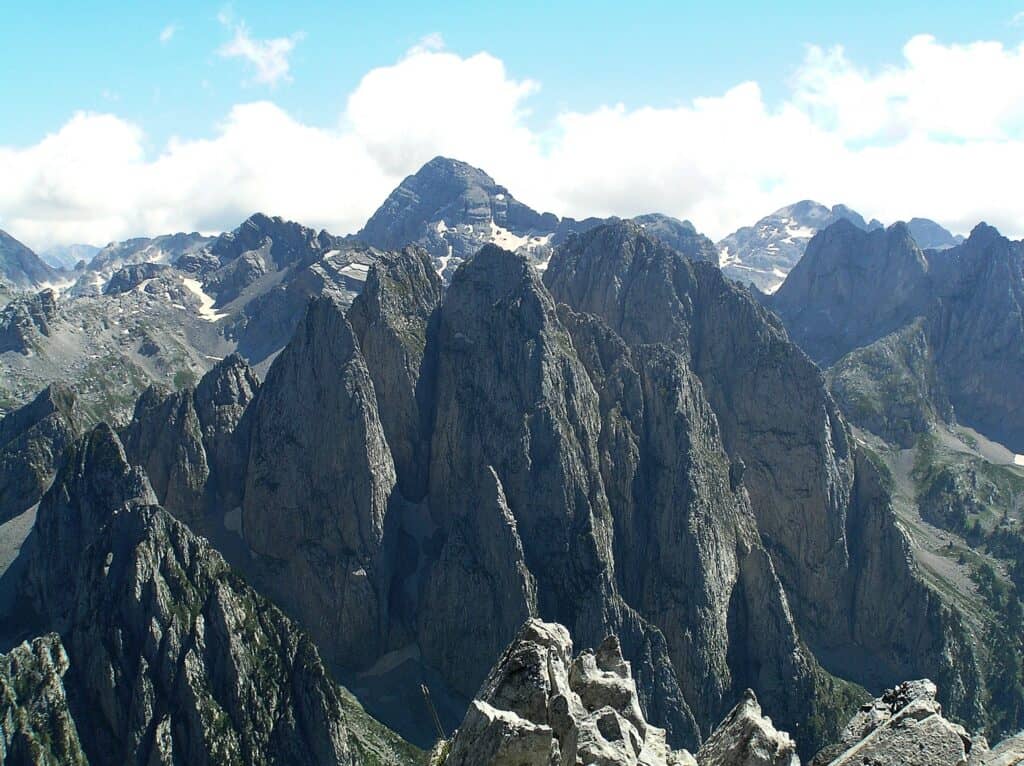
Alright, let’s crank up the altitude and delve into the raw, untamed wilderness of the Albanian Alps, an edgy mountain range that doesn’t play by the rules.
Albanian Alps
This isn’t your cookie-cutter mountain range. The Albanian Alps are a rollercoaster of craggy peaks, deep valleys, and diverse wildlife. Wolves, bears, lynxes, oh my! They’ve got ’em all. And let’s not forget the hundreds of bird species that call these mountains home. A day here feels like you’ve stepped into a David Attenborough documentary. Just remember, it’s their house, and we’re just visiting.
Hiking
The Valbona to Theth hike is the mountain’s best shot at breaking you. It’s a marathon, not a sprint – we’re talking 6-8 hours of rocky paths, dramatic vistas, and sheer determination. The payoff? Some of the best views in the whole country. Doing it solo is free, but if you prefer company, you can get a local guide to tag along for around 5000 lek ($44 USD or Euros). A fair price to avoid getting lost in the wilderness, don’t you think? We did it without but definitely wouldn’t hurt to have a guide.
Traditional Guesthouses and Local Customs

When the day’s done and your legs are screaming for mercy, flop down in one of the traditional guesthouses. For 3000-4000 lek ($26-$35 USD or Euros) per night, you get a cozy bed, home-cooked meals, and a crash course in local culture. Ever heard of ‘raki?’ This fiery local spirit is the highlander’s answer to a fun evening. It’s an acquired taste, but when in the Alps, right?
Getting There and Around
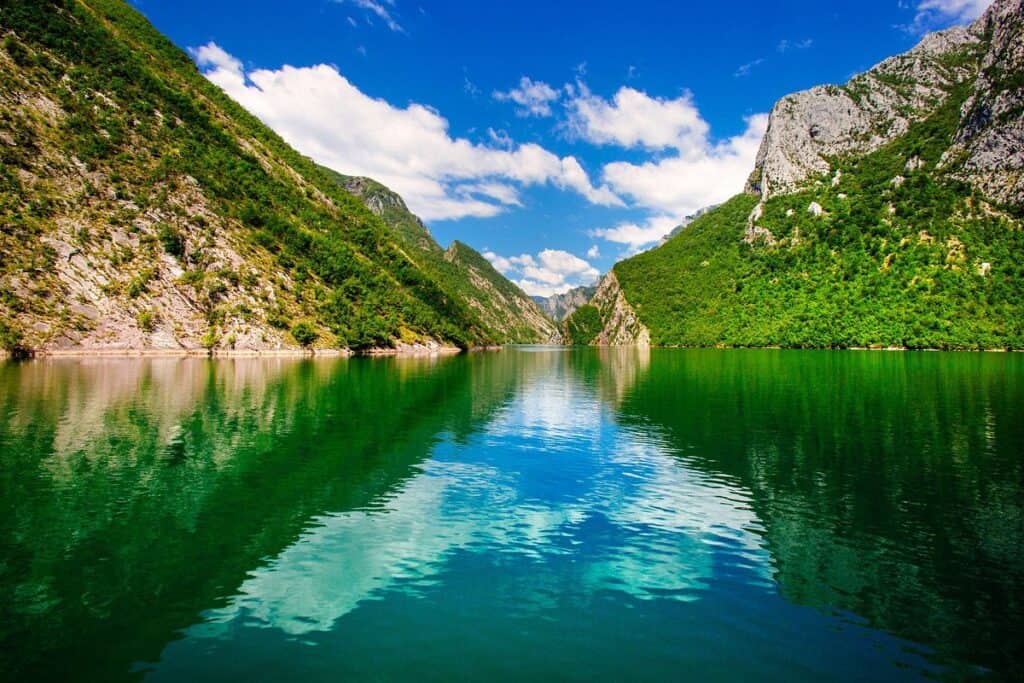
Getting to the Alps is half the fun. Hop on a ferry across the awe-inspiring Koman Lake for around 1000 lek ($9 USD or Euros). It’s a journey that’ll have your phone memory crying for mercy. Once you’ve landed in the Alps, minibuses and taxis are the way to go. They’ll zip you between mountain towns pretty fast.
Now that you’ve faced the ‘Accursed Mountains’ and lived to tell the tale, it’s time to regroup and get ready for the final week of your grand Albanian adventure
Week 4: Cultural Immersion in Berat and Krujë
Days 22-28
Alright, it’s time to wrap up this epic road trip in style. We’re heading to Berat and Krujë, two cultural heavyweights that’ll give you a real taste of Albanian life. Ready to get your mind blown? Let’s hit it.
Berat
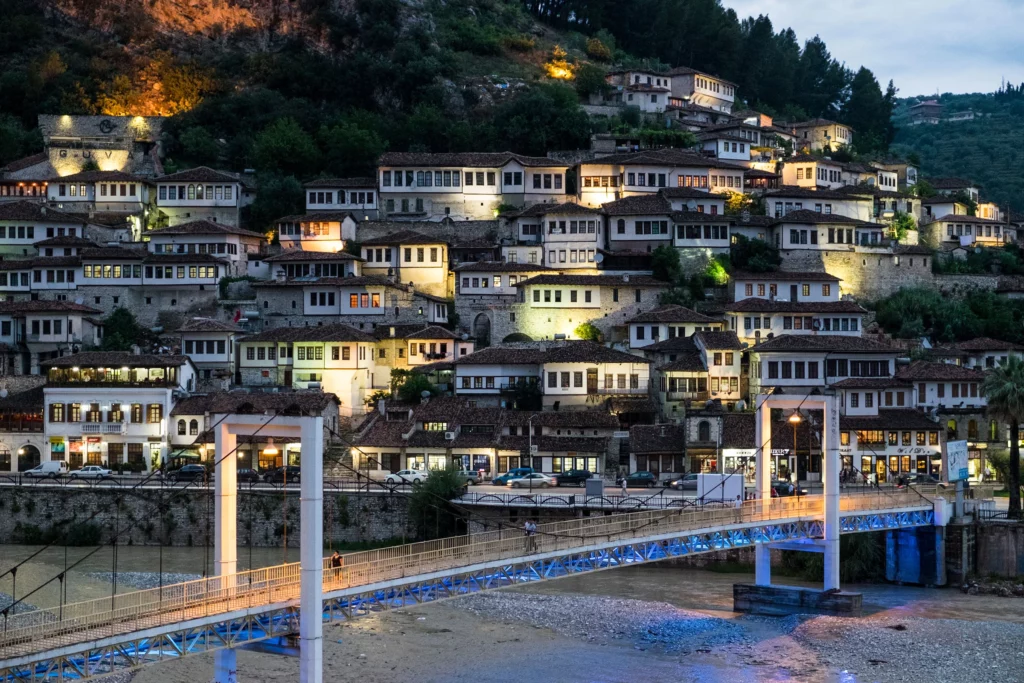
This is no ordinary city. Berat, aka the “city of a thousand windows”, is an artist’s dream come true. The city’s white Ottoman houses climbing up the hill towards the castle, their windows gazing out over the Osum River, will have your camera begging for mercy. The entrance to the Berat Castle is a bargain at just 200 lek ($1.75 USD or Euros). While you’re there, slip into the Onufri Iconography Museum inside the castle grounds, with its legendary icon paintings. It’ll set you back another 700 lek ($6 USD or Euros), but it’s worth every penny.
Krujë
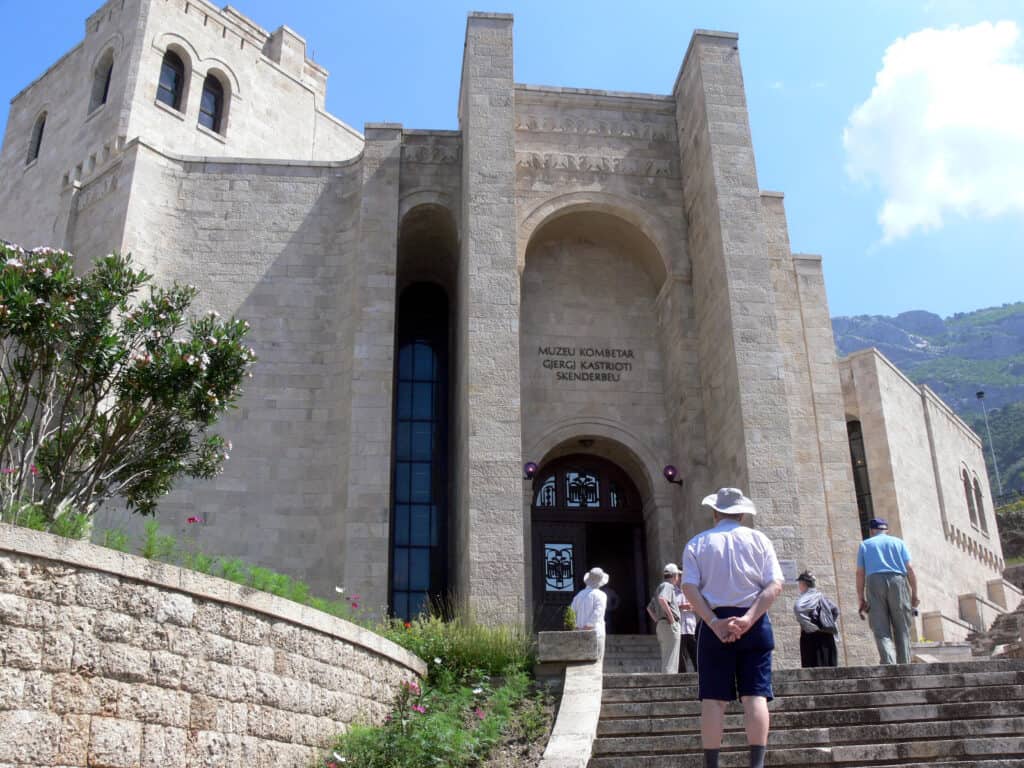
Next up, we’re hitting Krujë, a town that punches way above its weight. At the top of the list is the Skanderbeg Museum, dedicated to the national hero who gave the Ottomans a hard time. The entrance fee is 700 lek ($6 USD or Euros), and it’s worth every cent. Just next door, you’ve got the Krujë Castle, which offers spectacular views over the town and beyond.
After getting your historical fix, stroll through the Old Bazaar. This isn’t your average market. We’re talking centuries-old shops selling everything from traditional ‘qilim’ rugs to handcrafted copper coffee pots. Don’t be shy to haggle a bit – it’s part of the fun!
Culinary Traditions
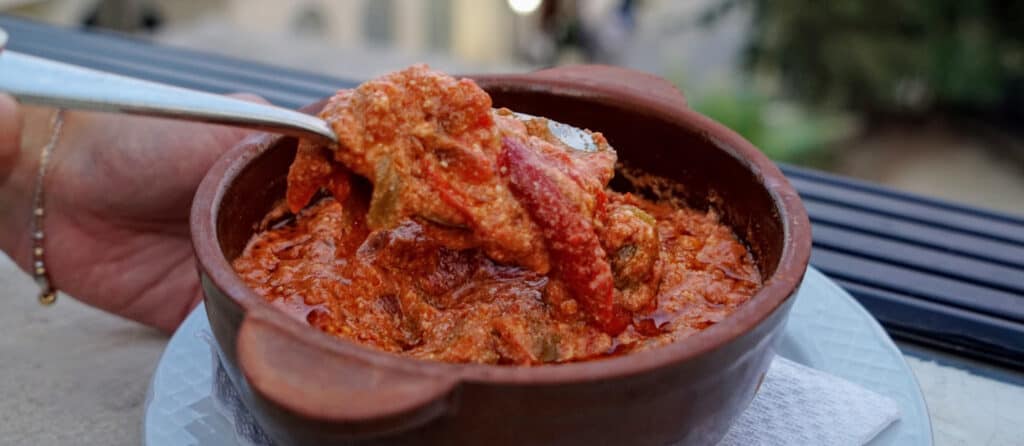
After all that walking, you’ll be starving. Both Berat and Krujë offer up some delicious local dishes. Try the ‘fërgesë’, a scrumptious blend of peppers, tomatoes, and cottage cheese. Expect to pay about 500-1000 lek ($4-$9 USD or Euros) for a hearty meal.
Transport
Getting to Berat from Tirana is straightforward. Regular buses run the route, costing around 300 lek ($2.60 USD or Euros) and taking about two hours. For Krujë, it’s even easier – minibuses depart from Tirana’s North Bus Station every 30 minutes, costing around 200 lek ($1.75 USD or Euros).
Inside the cities, your best bet is your own two feet. Most attractions are within walking distance, and the chance to wander through Berat and Krujë’s atmospheric streets is too good to pass up.
Well, that’s it. You’ve trekked through the mountains, lounged on the beach, dove into the culture, and ate enough ‘byrek’ to last a lifetime. But as we say in Albania, ‘Tungjatjeta’ – long life to you.
Cost and Budgeting
If you’re ready to start backpacking in Albania (good choice, by the way), it’s worth familiarizing yourself with their currency – the Lek. Here’s my personal take on it.
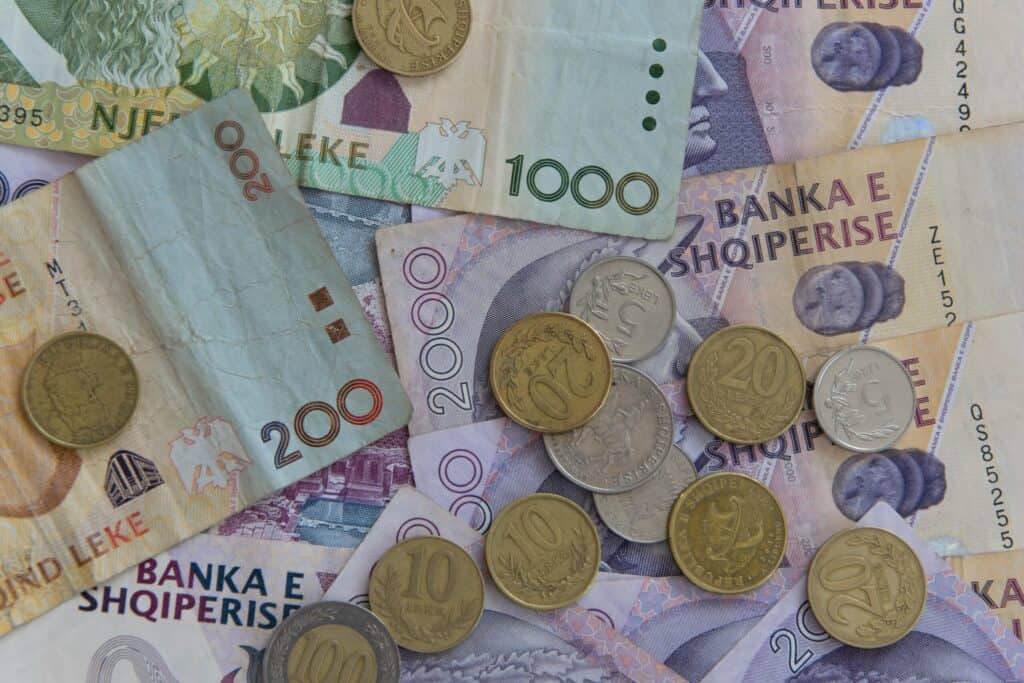
The Basics: Coins and Notes
So, the Albanian Lek, or “Leke” in plural, comes in coins and banknotes. The coins range from 1 Lek all the way to 100 Leke, and the banknotes start at 200 and go up to 5,000. It’s kind of cool, each note and coin is a different color, size, and has different historical figures on them. Makes paying for that morning coffee a little more interesting.
What it’s Worth: Exchange Rates
Back in 2021, you’d get around 100-110 leke for a US dollar. But let’s be honest, exchange rates have a mind of their own. It’s a good idea to check out a site like XE or OANDA to get the latest rates before you leave.
Where to Get Your Lek:
No shortage of places to swap your cash for leke. You can head to a bank, hotel, or licensed exchange bureau. ATMs are all over in major cities and touristy spots. I should mention, while you’ll see card readers in most places, especially in bigger cities, in rural Albania, cash is still the preferred way to pay, especially in smaller towns and markets.
Dealing with Prices
When you’re out shopping or grabbing a bite, you’ll notice prices are typically listed in leke. Sure, some tourist-friendly spots might list prices in Euros or even accept them, but I’ve always found it easier to just stick with the local currency to avoid any confusion or unexpected exchange rates.
Cost of Living
Breaking down the cost of living by city helps you allocate your budget according to your travel plans and ensures your Albanian adventure is as smooth as possible.
Accommodation: A Room for Every Budget
Albania’s accommodation spectrum is impressively broad, catering to both shoestring backpackers and luxury seekers.
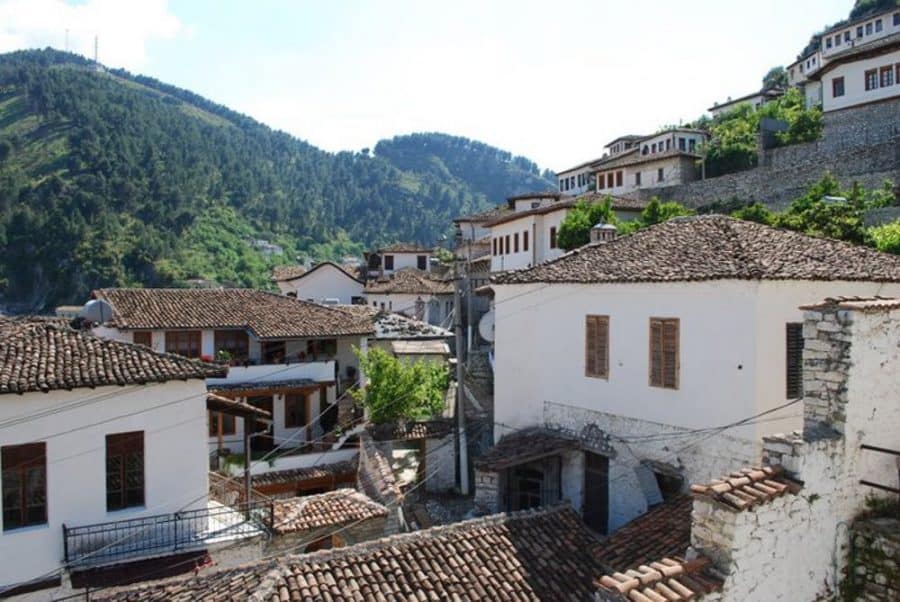
Budget Accommodation
In Tirana, the heart of Albania, you can secure a decent hotel room for around $30 USD or Euros per night. This would typically offer basic amenities like a private bathroom, free WiFi, air conditioning, and perhaps breakfast. Even more economical are the hostels, where a dorm bed costs between $10-$15 USD or Eurosper night, providing an excellent opportunity to meet fellow travelers.
Mid-range Accommodation
For those seeking a bit more comfort, mid-range hotels, priced around $40-$60 USD or Euros, offer more spacious rooms, often including services like room service, an in-house restaurant, and sometimes a pool.
Luxury Accommodation
High-end luxury hotels can cost upwards of $70 USD or Euros per night, providing top-tier amenities, including fine dining, spas, fitness centers, and often located in prime city locations or offering breathtaking views.
Accommodation in the Major Cities
Tirana
In the buzzing capital, you can secure a good hotel room for around $30 USD or Euros per night. If you’re willing to spend more, a high-end hotel like the Plaza Tirana can cost over $100 USD or Euros per night. For budget travelers, hostels like the Tirana Backpacker Hostel offer beds from $10-$15 USD or Euros per night.
Sarandë
In this coastal city, budget hotels near the beach can be found for about $20 USD or Euros per night. For a more luxurious experience, upscale hotels such as the Santa Quaranta Premium Resort start at around $100 USD or Euros per night.
Gjirokastër
Here, traditional guesthouses like Kerculla Resort offer rooms for about $30 per night, allowing you to experience the local culture up close.
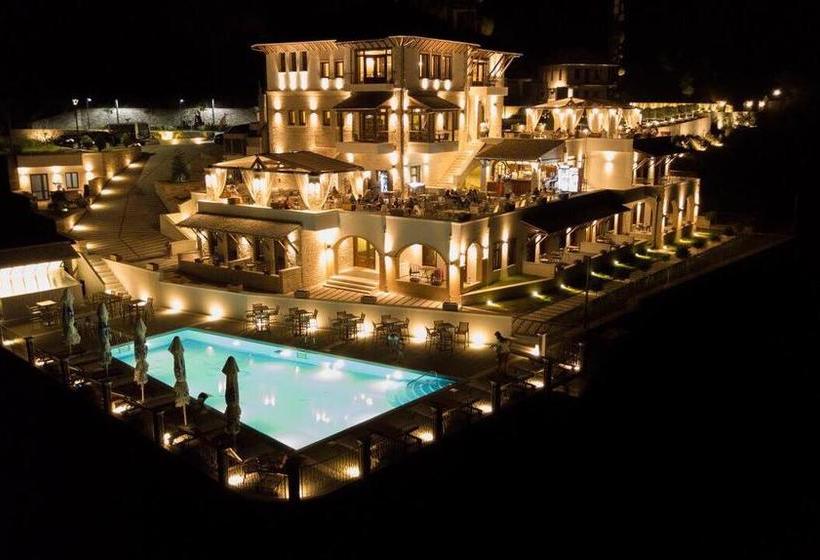
Food and Drink
Albania is one of the best spots that serves hearty meals that won’t empty your wallet.
Eating on the Cheap – Street Food
Going local with your food choices isn’t just a budget saver, it’s also a great way to dive into Albania’s rich culinary tradition. Look out for family-run tavernas and roadside eateries – they often serve hearty, homemade dishes for a fraction of the cost you’d pay at more touristy places. You can grab a delicious byrek, a kind of flaky pastry with different fillings, or a bowl of fasule, a traditional bean soup, for just a couple of leke.
The streets of Albanian cities are lined with vendors offering local delicacies like byrek, a flaky, savory pastry filled with cheese, spinach, or meat. These are not only delicious but also extremely pocket-friendly, costing less than $2 USD or Euros. Here are a few popular spots for you to consider while exploring the country:
Tirana
Pazari i Ri (New Bazaar)
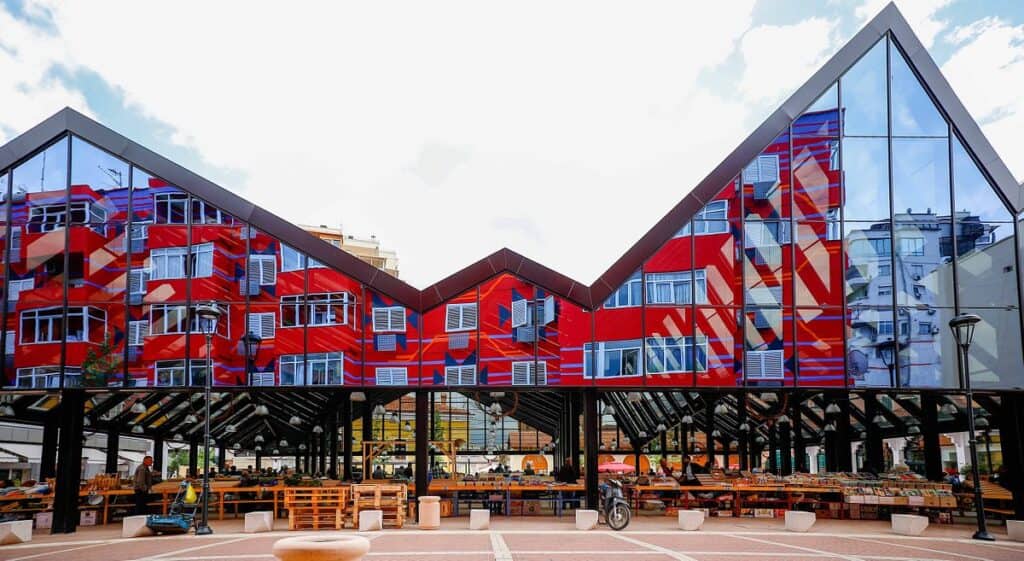
This vibrant market is not just a place to buy fresh local produce, but also a popular spot for various food stalls. Be sure to try out ‘Qofte’, the Albanian meatballs, from one of the vendors here.
Rruga Kavajes

Known for its assortment of street food vendors, this area is a must-visit. Try ‘Byrek’, a traditional Albanian pie filled with various ingredients like cheese, spinach, or meat.
Durres
Zgara Korcare
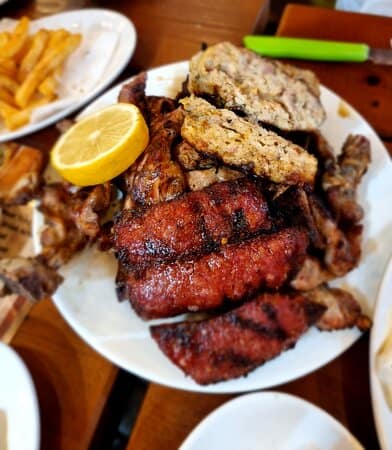
While not a single location, Zgara Korcare is a popular type of eatery you can find in many towns, serving grilled meat dishes, typically accompanied by local beer. The one in Durres is particularly popular.
Shkodra
Rruga Luigj Gurakuqi
This street in Shkodra is known for its eateries that serve delicious ‘Roasted Lamb’, a dish that’s very popular in the region.
Pogradec
Liqeni i Pogradecit
If you’re into seafood, this area around Lake Pogradec is renowned for its grilled Koran, a trout unique to this region.
Berat and Gjirokaster
Local Bazaars
Wander around the bazaars in these historic towns, and you’ll find various vendors selling local delicacies, including home-made Jufka (a type of pasta) and local cheeses.
Restaurants
A sit-down meal at a mid-range restaurant in Albania will typically cost between $5 and $10. These establishments offer a wide array of local dishes, like seafood caught fresh from the Ionian Sea, or slow-roasted meats, accompanied by locally produced wine or beer.
Tirana
Era Restaurant:
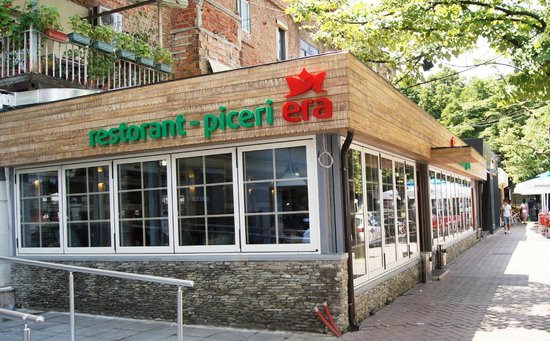
This place serves traditional Albanian dishes. It’s popular among locals and tourists alike, and you can enjoy a good meal here for around 700-1500 Lek (7$ to 15$ USD or Euros).
Mullixhiu

For a modern take on Albanian cuisine, head to Mullixhiu. The price range is slightly higher, with meals costing between 1000-2500 Lek (10$ to 25$ USD or Euros)
Albanian Alps:
Traditional Guesthouses:
When you’re in backpacking in Albania in Theth or Valbona, enjoying the amazing hike, the local hospitality is the best when dining at one of the guesthouses. They offer home-cooked meals, usually included in the accommodation price. If not, expect to pay around 500-1000 Lek (5$ to 10$ USD or Euros) for a hearty meal.
If you’re looking to do the Theth the Valbona hike, be sure to read our guide!
Saranda:
Bar Restaurant Limani:
A favorite among seafood lovers, this place offers excellent fish dishes. An average meal can cost between 700-2000 Lek (7$ to 20$ USD or Euros)
Mare Nostrum Cuisine:
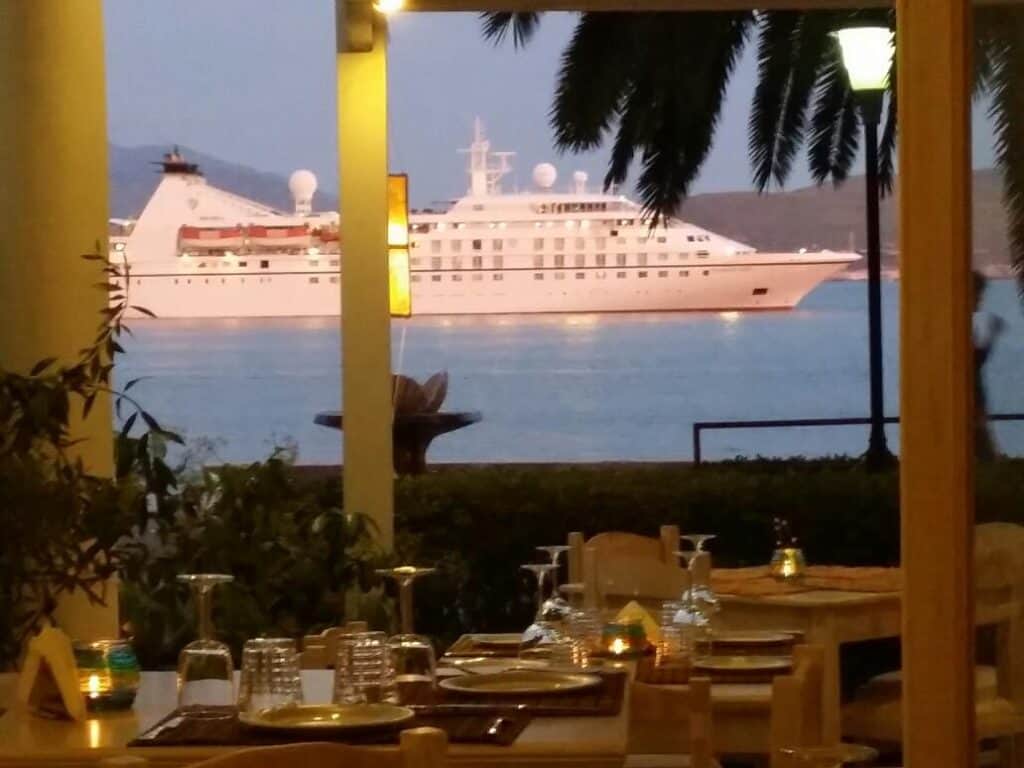
Another great spot for seafood lovers, this restaurant combines delicious food with stunning sea views. Expect to pay between 1000-2500 (10$ to 25$ USD) Lek for a meal.
Fine Dining
For an upscale dining experience, expect to pay around $20 USD or Euros and up per person. These places usually offer a gourmet experience, featuring the best of Albanian cuisine and a curated selection of wines.
Tirana
Padam:
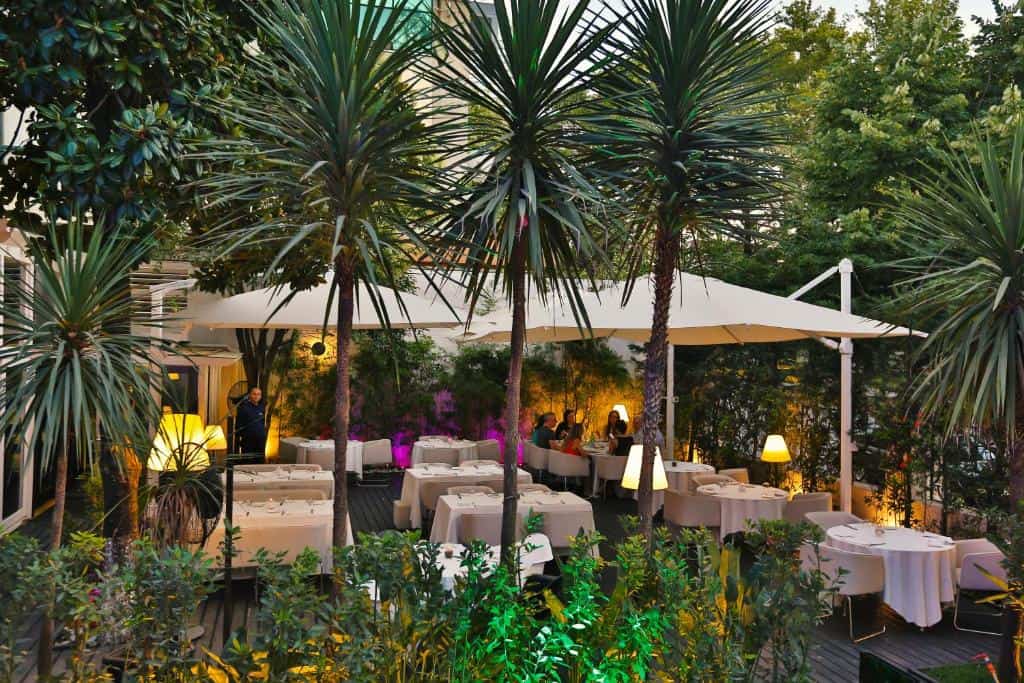
A chic, upscale restaurant that offers a fusion of Albanian and Italian cuisine. Their menu changes with the seasons, ensuring fresh and exciting flavors. The average cost per person, without drinks, ranges from 2000-4000 Lek (20$-40$ USD or Euros).
Zeri I Nates
This place offers excellent steak and wine options. You can expect to spend around 3000-5000 Lek (30$-50$ USD or Euros) per person here, without drinks.
Durrës
Troy Piceri Grill House
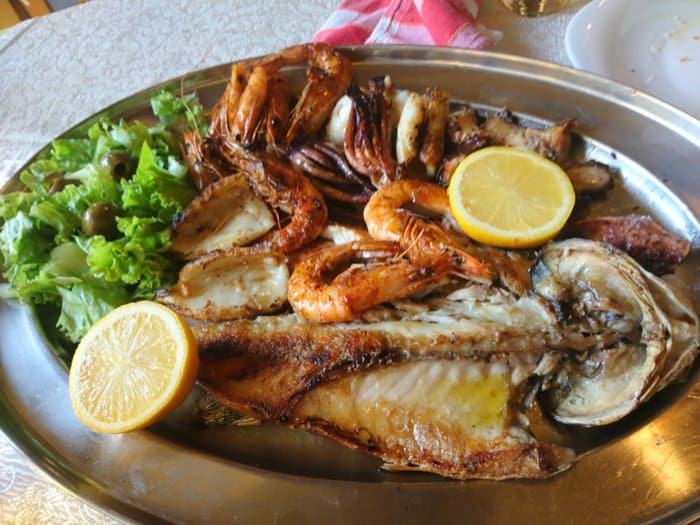
This upscale restaurant offers a fantastic view of the Adriatic Sea alongside its menu of fresh seafood and grill items. You can expect to pay around 2000-4000 (20$ to 40$ USD or Euros) Lek per person.
Vlorë
Restaurant Amantia
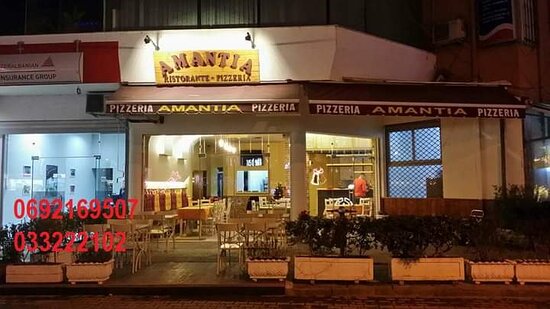
Perched on a hill overlooking Vlorë, the restaurant offers a mix of seafood and traditional dishes with a panoramic view of the city. The average cost per person is between 2000-4000 Lek.
Saranda
Guvat Restaurant
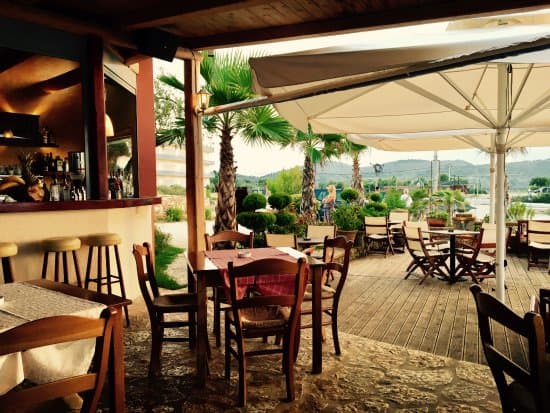
Known for its stylish decor and breathtaking views of the Ionian Sea, Guvat serves a variety of dishes, including fresh seafood. A meal here might cost you around 3000-5000 Lek per person.
Shkodra
Tradita Geg & Tosk

This is an elegantly decorated restaurant offering a variety of traditional Albanian dishes. You can expect to pay around 2000-4000 Lek per person.
These restaurants offer an elevated dining experience and the chance to try refined Albanian cuisine. However, do remember that these are more premium options and the prices reflect that. Still, for a special occasion or just to treat yourself, they are worth checking out.
Transportation in Albania
Getting around Albania is affordable and part of the adventure.
Local Transportation
In cities like Tirana, local buses are a cheap and efficient way to get around, with tickets costing less than a dollar.
Intercity Travel
For longer distances, you can use furgons or minibuses. These intercity minibuses are an authentic Albanian experience, costing between $2 and $5 depending on the distance.
Car Rentals
For those who prefer more independence, car rentals are available starting from around $20 per day. Keep in mind that Albanian road conditions vary, and driving styles can be aggressive, for example driving in cities like Shkodër, known for its narrow streets, might be a bit challenging.
Attractions: Experiencing Albania’s Best
Albania is generous when it comes to offering attractions, many of which are free or relatively inexpensive. Albania’s rich history and stunning landscapes make it an attractive destination for sightseeing.
Natural Wonders
Most of Albania’s natural wonders, including its pristine beaches, stunning mountain trails, and picturesque national parks, are free to explore.
Museums and Historical Sites

The country is rich in history, and entrance fees to museums and historical sites are typically very reasonable. For example, the National Historical Museum in Tirana charges around $3 for entry, while the ancient ruins of Butrint, a UNESCO World Heritage site, costs about $5.
Tirana
The entrance fee for the National Museum is around $3, providing an in-depth look at Albania’s history.
Butrint
Near Sarandë, the ancient city of Butrint, a UNESCO World Heritage Site, charges about $5 for entry.
Berat
Exploring the town’s historic district, a UNESCO site known as the “City of a Thousand Windows”, is free of charge.
The Finer Details
When planning your budget, don’t forget the smaller but significant costs.
Souvenirs
Traditional Albanian handicrafts like embroidery, filigree jewelry, or ceramic items can range from a few dollars for small trinkets to several hundreds for larger, more intricate pieces
At the local markets, handmade crafts like traditional qeleshe hats or filigree jewelry can range from $10 to over $100.
Tipping
While not mandatory, it’s customary to tip around 10% of your bill in restaurants. In cities like Vlorë, known for its hospitality, you might find the service deserving of a little extra.
Tips on how to travel on a budget (e.g., eating local food, staying in hostels).
Albania is an amazing country that offers so much, even when you’re keeping an eye on your wallet. Trust me, I’ve been there, and I’ve gathered some smart tips to help you make the most out of your trip without breaking the bank.
Finding Affordable Lodging
Accommodation can eat up a huge chunk of your budget if you’re not careful. Luckily, backpacking in Albania offers plenty of opportunities to find affordable places to rest your head. Hostels are a great choice – they’re not only cheap but also a great place to meet fellow travelers.
Hostels

Tirana Backpacker Hostel, is more than just a place to crash. It’s a hub where travelers converge, sharing stories, tips, and forming connections that span continents.
The rooms are practical, offering dorm-style or private spaces, depending on your preference. Shared facilities add to the communal vibe, presenting countless opportunities for interactions that could turn into lasting friendships.
The staff are always willing to guide, and are as much a part of your travel experience as the city itself. The communal area is where people get together, and share their intriguing stories.
Its central location is a plus, with the historic Skanderbeg Square and National Historical Museum just a few steps away. For a budget-friendly, character-filled stay that promises engaging encounters, Tirana Backpacker Hostel has you covered. Check their official website and you’ll see many positive reviews.
Stone City Hostel in Gjirokastër
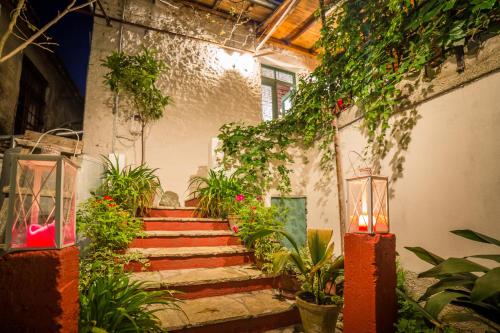
Stone City Hostel in Gjirokastër is a traveler’s haven situated in a beautifully restored traditional house. You get a warm, welcoming environment, and it’s a great base for exploring Gjirokastër’s UNESCO-protected old town. The place offers comfy, clean rooms and has a friendly, knowledgeable staff, ready to assist and enhance your stay.
Guesthouses
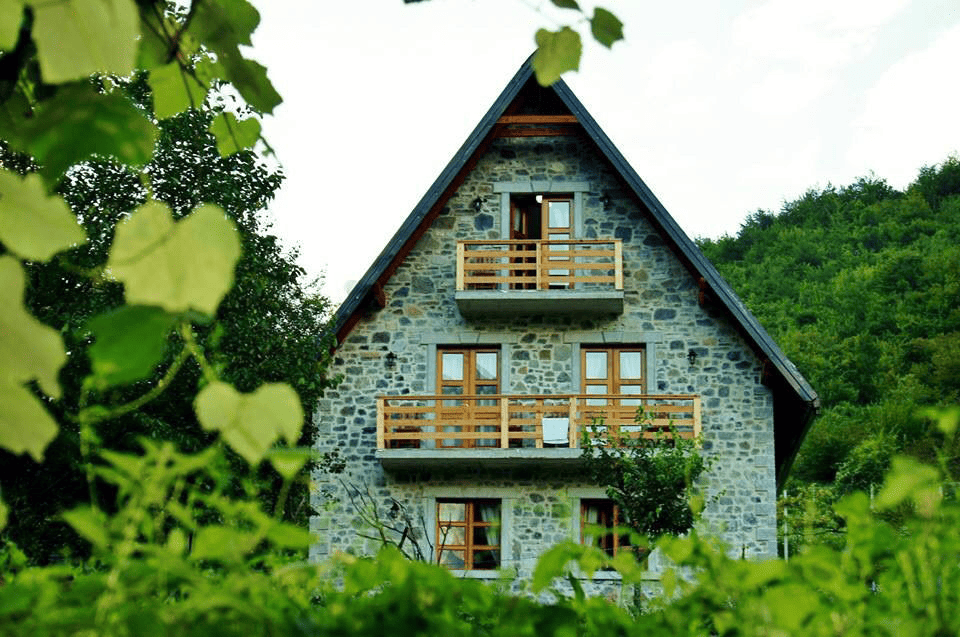
Nestled amidst the Albanian Alps, Villa Gjecaj brings you an experience rooted in local traditions. Housed in a picturesque stone building, this guesthouse offers comfortable rooms with views that are worth waking up to. The staff are super helpful, ready to guide you on your hiking adventures. Don’t forget to try their locally sourced homemade meals – they’re truly authentic and delicious.
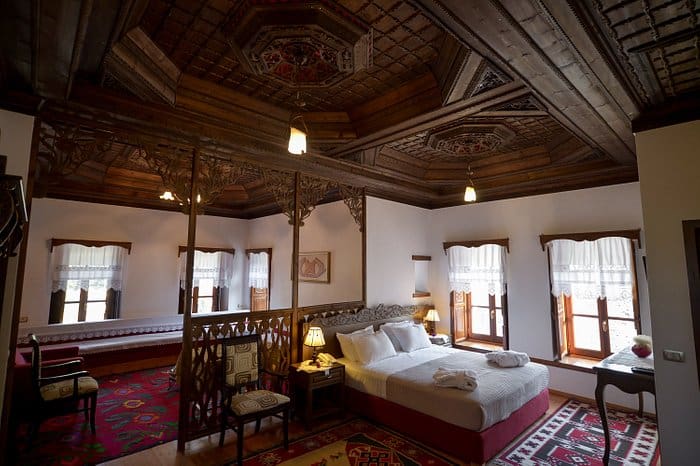
Hotel Kalemi gives you a real sense of the rich history of Gjirokaster. It’s located in a traditional Ottoman-style house, equipped with antique furniture that will take you back in time. The panoramic views of the old town from the terrace are unforgettable. The owner’s hospitality is noteworthy, with useful local tips, and they serve a fantastic traditional breakfast.
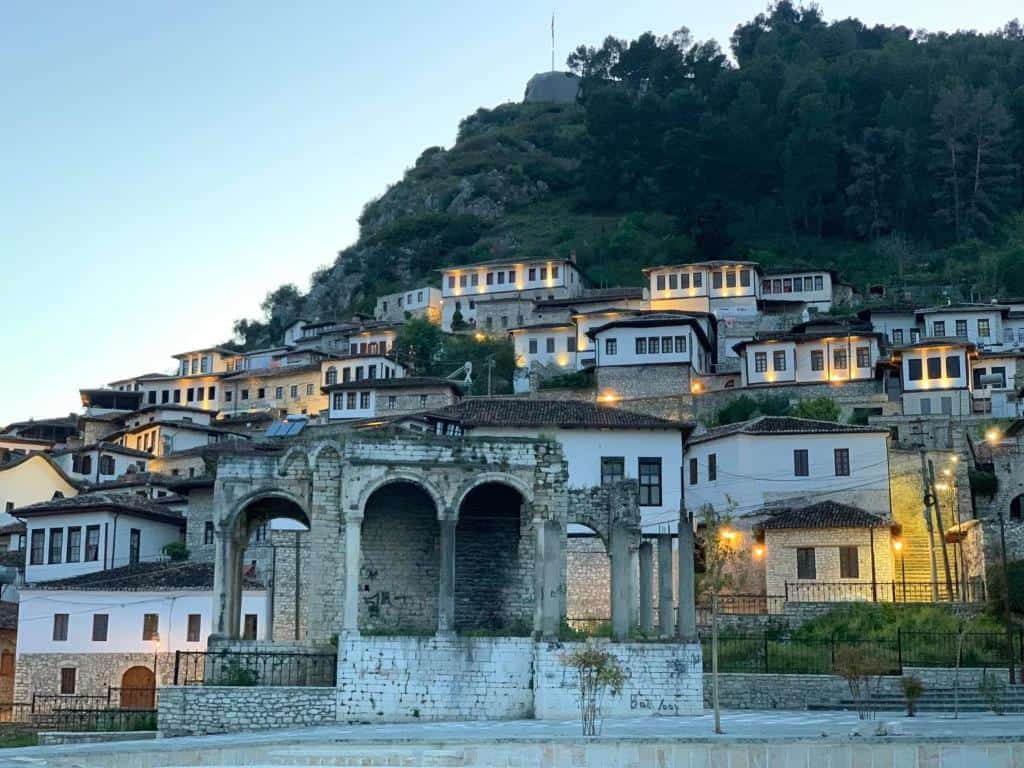
If you want to feel the heart of Berat, staying in Guest House Arber Quemeri is a must. This guesthouse is conveniently located within the UNESCO world heritage site, Berat Castle, providing easy access to the city’s main attractions. The rooms are clean and cozy, and the host, Arber, often goes out of his way to ensure guests have a memorable stay. Don’t miss the delicious homemade wine and raki here!
Budget Hotels
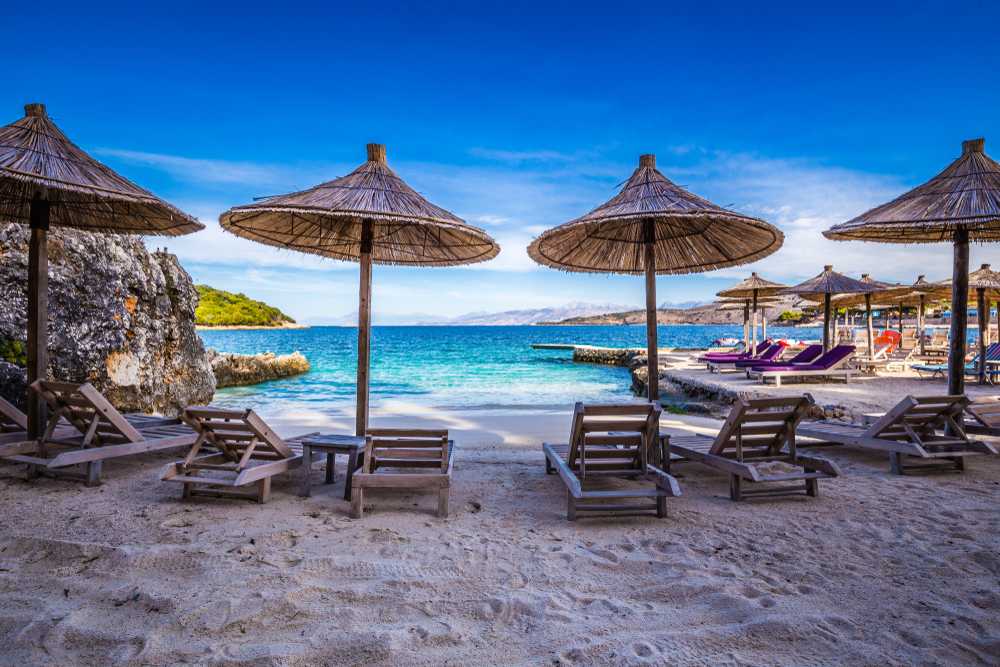
Located in the heart of Tirana, this budget hotel offers neat, comfortable rooms with all essential amenities. It’s within walking distance to many city attractions, making it a convenient base for exploring the city. The staff are very helpful and friendly, and there’s a breakfast buffet with a decent spread to kick-start your day.
A gem in Berat’s historic district, Hotel Mangalemi offers budget-friendly accommodation in a beautifully restored traditional building. The rooms are comfortable and clean, and many offer views of the iconic “thousand windows” of Berat. The restaurant serves tasty local cuisine, and the inclusive breakfast is a hit among guests. Its central location makes it a great base for sightseeing.
Safety in Albania
This Balkan gem is not just rich in culture and natural beauty, it’s pretty safe, too. However, no matter where you’re journeying, it’s always smart to know your way around. So, let’s get into some practical tips for safely navigating your Albanian adventure.
General Safety Tips:
Dealing with the Locals
First things first, Albanians are generally hospitable and go out of their way to help, particularly in smaller towns and villages. You’ll likely have locals offering to help you find your way or even invite you in for a coffee – that’s the Albanian way. But as with anywhere, always keep an eye on your stuff, particularly in crowded public places like markets or bus stations. It’s not that Albania has a high rate of theft – it’s pretty low actually – but it’s always better to stay cautious, right?
Getting Around Safely
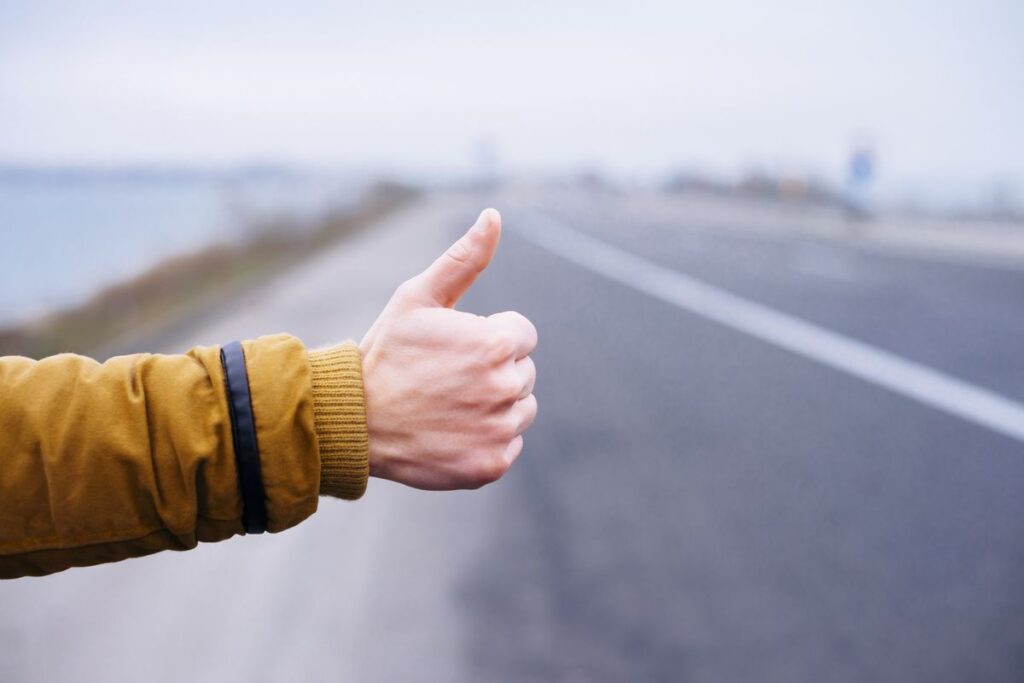
If you’re considering renting a car in Albania, well, it’ll be an adventure. The driving etiquette here is, let’s say, ‘open to interpretation’. The safer and less stressful option is probably to use public transport. Albania has a decent network of buses and furgons (minivans) connecting towns and cities. Hitchhiking is also pretty common and generally safe, but as always, use your judgement and trust your gut.
Night Time Safety
City life in Albania, especially in Tirana, is vibrant even after sundown. It’s safe to walk around, but like in any city, it’s best to stick to well-lit areas with people around. If you’re heading back late from a bar or a club, grab a taxi – they’re not expensive, and it’s always safer.
Beach Safety
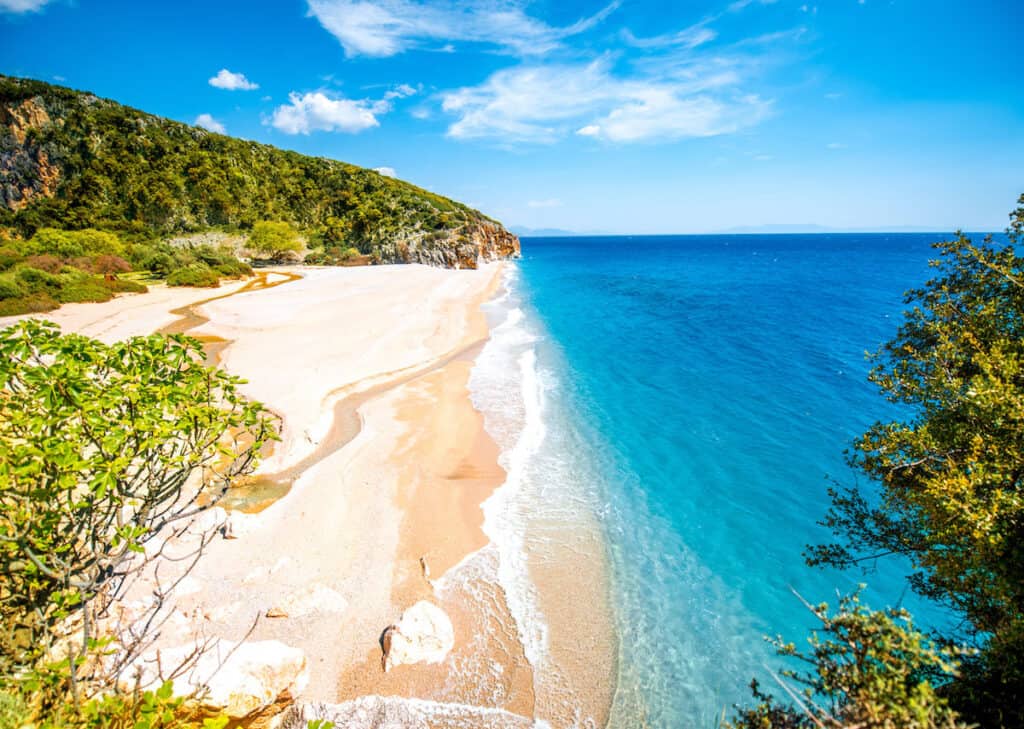
Ah, Albanian beaches. They’re beautiful, but remember, not all are patrolled by lifeguards. The sea can change quickly, so be cautious, especially if you’re going for a swim alone. And remember, the Albanian sun can be intense – lather up that sunscreen!
Hiking in Albania
Albania’s mountains and hiking trails are a nature lover’s dream. The views are spectacular, but the terrain can be challenging and weather conditions unpredictable. Always let someone know where you’re heading, check the weather forecast beforehand, and if possible, find a hiking buddy.
Albania is a fantastic country to explore, especially if you’re backpacking. With a little bit of caution and a lot of enthusiasm, you’re ready for an amazing adventure.
Checking for Travel Advisories
When you’re planning your backpacking journey through Albania, staying current on travel advisories is a must. Now, keep in mind I’m an AI with a last update in 2021, so I can’t give you real-time alerts. But I can tell you where to find the most up-to-date, relevant info.
Check Your Government’s Official Travel Websites
The first place to look for advisories is your country’s foreign affairs department website. For my American friends, that’s the U.S. Department of State’s website. UK folks, you’re going to want to head to the Foreign and Commonwealth Office’s site. You get the drill.
World Health Organization – A Reliable Source
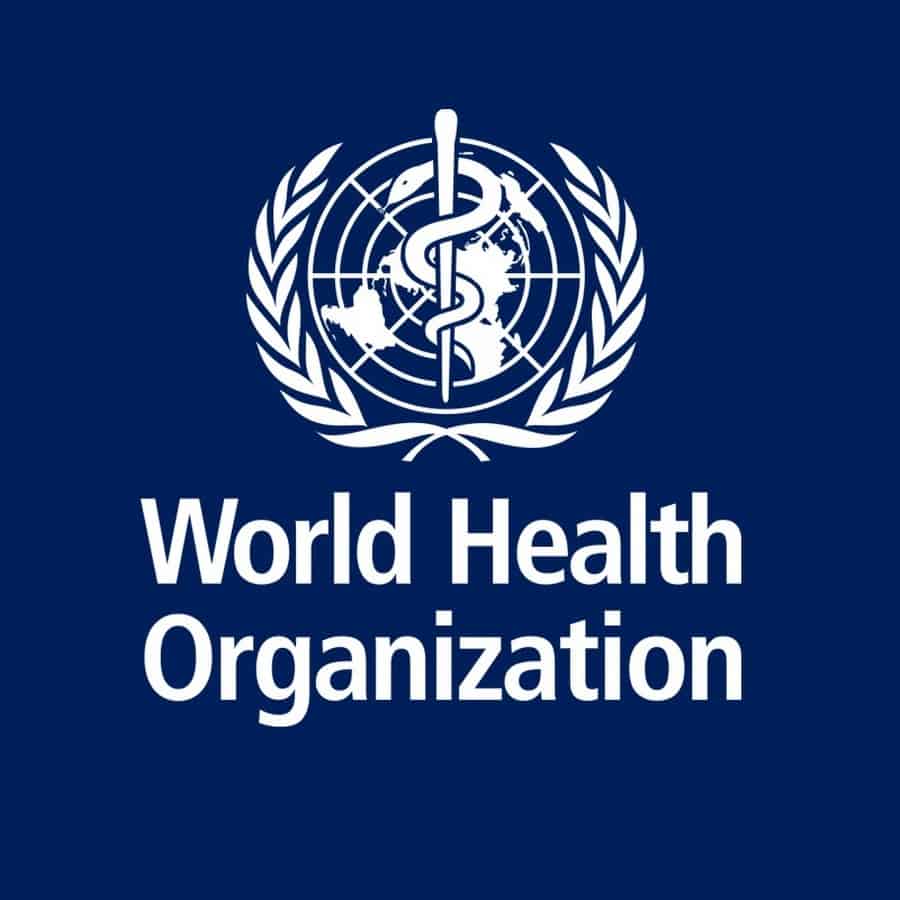
The World Health Organization is a go-to for health advisories. They’ve got the lowdown on health issues, like that pesky COVID-19, as well as info on necessary vaccinations and more.
Keep Your Finger on the Pulse with Local News
Dig into local news sources in Albania. You might need to brush up on your Albanian, but many sites offer English translations and can provide useful insights into the country’s current happenings.
Get Personal with Online Travel Communities
Communities like Lonely Planet, TripAdvisor, or travel-focused Reddit threads are goldmines of information. They’re places where fellow backpackers share recent experiences, giving you a taste of what’s happening on the ground.
Now, remember, advisories are there to keep you informed, not to scare you off. Sure, they often highlight potential negatives, but they usually don’t represent the everyday experiences of travellers. It’s about finding that balance between having the time of your life and staying safe.
Emergency Contacts in Albania
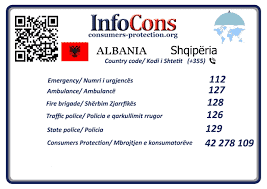
Even the most meticulously planned trip can encounter a bump or two along the road. It’s always good to have some safety nets in place. So, here’s the 411 on emergency contacts in Albania.
Remember ‘112’
112 is your buddy in Albania. Dial it, and you’re connected to the country’s main emergency line, ready to dispatch police, fire, or medical services your way. It’s toll-free and can be dialed without a sim card, making it incredibly handy in a pinch.
Embassy or Consulate Contacts
It’s worth noting down the contact details of your country’s embassy or consulate in Albania. They can help out if you lose your passport, encounter legal trouble, or if there’s a country-wide emergency.
Insurance Provider
Have your travel insurance provider’s hotline saved. If you need medical assistance or need to understand your coverage in an unforeseen situation, they’re your first point of contact. If you’re a solo traveler, check out Nomad’s Insurance guide!
Local Contacts
If you’ve got local friends or if you’re staying at a hostel or Airbnb, it’s smart to save your contact’s number. They can help translate, guide you to the nearest medical facility, or give local advice in tricky situations.
Preloaded Maps
Keep a map of Albania preloaded on your phone. Google Maps allows you to download maps for offline use, so you’re never truly lost even without internet access.
Remember to always verify these numbers before you travel as they might change over time. Your safety and security are important, and having these numbers on hand will be incredibly beneficial during your travel in Albania.
Transportation
Public Transportation in Albania: A Closer Look
While it might be tempting to grab a cab everywhere, public transportation in Albania is cheap and can add a bit of an adventure to your travel..
City Buses
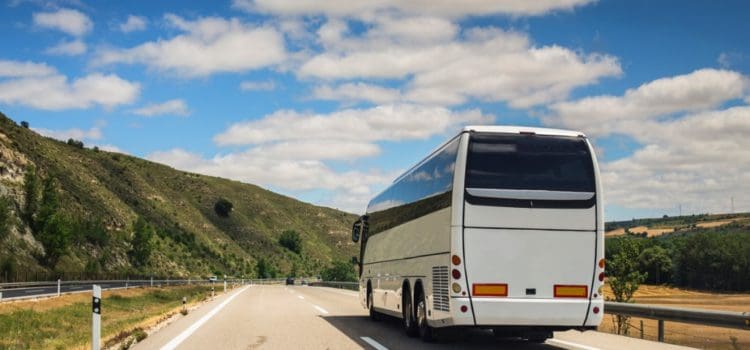
Buses are pretty much the backbone of Albania’s public transport system. In cities like Tirana, you’ve got local buses connecting different parts of the city. It’s cheap and often quite the cultural experience. In Tirana, local bus fare is around 40 lek (less than $0.50), and a monthly pass costs 2,000 lek ($18).
Intercity Buses and Furgons
For intercity travel, furgons (minibuses) and coaches are your go-to. They don’t usually operate on a fixed schedule. Instead, they depart when they’re full. For long-distance travel, they are your best bet. Fares depend on distance but to give you an idea, a trip from Tirana to Shkodra (a 2-hour journey) usually costs around 500 lek ($4.50).
Trains – The Slow Adventure
Trains are not the fastest nor the most reliable means of transportation, but they offer scenic routes.For instance, a journey from Tirana to Shkodra might cost around 300 lek ($2.50). However, as of my knowledge cutoff in 2021, the train system was limited, and schedules might be irregular. Always double-check the latest information.
Taxis – Quick and Handy
Compared to many other European countries, taxis are pretty affordable in Albania, especially if you’re splitting the fare. Rates can vary, but you can expect to pay around 300 lek ($2.50) for a short ride within the city. Longer trips, like from Tirana to Durres (around 35km), could cost around 3,500 lek ($30). They’re a great option for when you’re loaded down with gear or making your way to a remote hostel.
Biking – Budget-Friendly and Scenic
Renting a bike can be a great way to get around in certain towns.It’s environmentally friendly, gives you the freedom to explore at your own pace, and is a great way to soak up the local atmosphere. For example, in Shkodra, known for its bike-friendly streets, rentals go for around 500 lek ($4.50) per day.
Ferries – Gateway to Remote Beauty
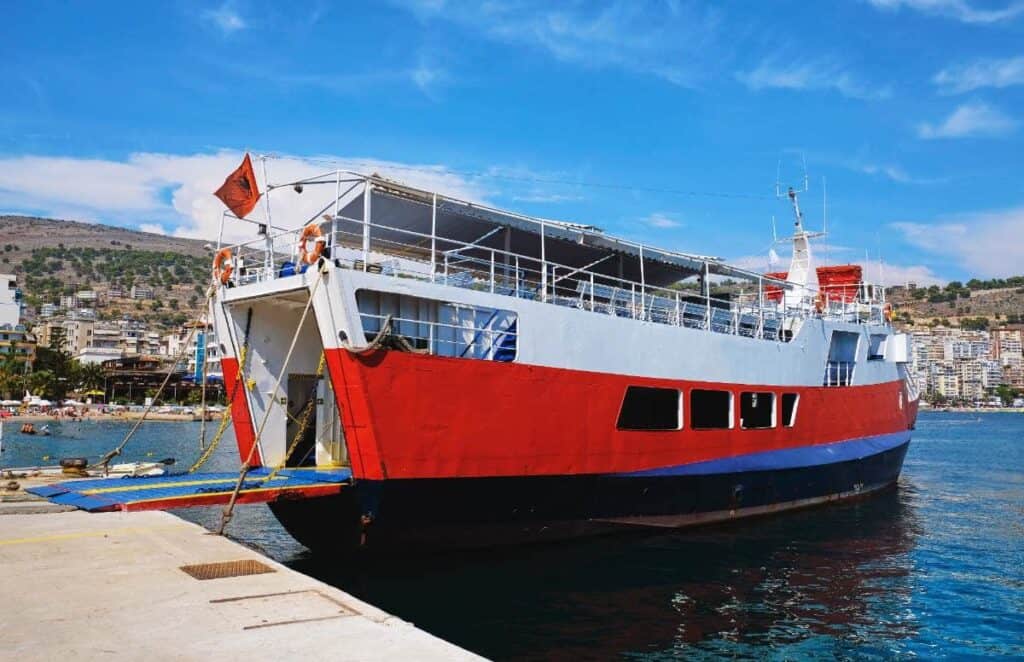
Ferry rides, such as the Lake Koman Ferry, cost around 700 lek ($6) one way. It’s not just a ride, it’s a scenic experience that takes you to off-the-beaten-track locations like Valbona.
These prices should give you a rough idea of transportation costs in Albania, but remember, prices can vary, so always double-check. Also, haggling over taxi fares is common, so don’t be afraid to negotiate.
Renting Cars and Bikes
Sometimes, having your own set of wheels can add a new level of freedom to your adventure. In Albania, you have options.
Car Rentals
Renting a car in Albania opens up possibilities to explore at your own pace. Major cities like Tirana and Durres have plenty of car rental agencies, including international chains like Hertz, Europcar, and local providers.
The cost of renting a car usually starts from around 3,000 lek ($25) per day for a basic model, going up depending on the type of vehicle and rental period. Remember, this does not include fuel (which is around 200 lek/$1.70 per liter) and any additional charges like GPS or extra insurance.
Driving in Albania is an adventure itself, and I mean it in every sense of the word. Some roads are well-maintained, but others can be a bit rough around the edges. Traffic rules are, let’s just say, loosely interpreted by local drivers. Therefore, always stay alert and drive defensively.
If you’re more about two wheels and the wind in your hair, renting a bike could be the way to go. Bike rentals are more popular and readily available in certain towns. Shkodra, for instance, is known for its bike-friendly culture, and you can find rentals for around 500 lek ($4.50) per day.
In Tirana, the bike-sharing program, Mobike, is a good option for short-term use. Download the app, scan the QR code on the bike, and you’re good to go. Rides cost around 60 lek ($0.50) for 30 minutes.
Albania’s terrain can be quite hilly, so plan your routes accordingly.
For a bit more speed, renting a motorbike or scooter might be the way to go. In popular tourist destinations like Saranda, you can find scooter rentals for around 3,000 lek ($25) per day.
Remember, whether you’re on four wheels or two, safety comes first. Always wear a helmet when biking, keep an eye on the road conditions, and make sure your travel insurance covers any potential mishaps on the road.
Navigating on Foot
Albanian cities, particularly Tirana, are walkable. Most points of interest, restaurants, and cafes are located within walking distance in the city centers. It’s not only a great way to save money, but you can also stumble upon hidden gems in the winding streets.
Hiking
Albania’s countryside, particularly the northern region, is home to some breathtaking hiking trails. Walking can often be the best way to explore these parts, whether you’re traversing the Albanian Alps or strolling through idyllic villages in the south. Always have a reliable map or GPS, inform someone about your plans, and take plenty of water and snacks.
But if you dont..
Ask Locals
In rural areas, signposts can be rare, and GPS may not be the most reliable. When in doubt, don’t hesitate to ask locals for directions. Albanians are incredibly hospitable and will often go out of their way to help, even if it means leading you to your destination themselves.
Week 1: Unraveling Tirana
Day 1 to Day 4
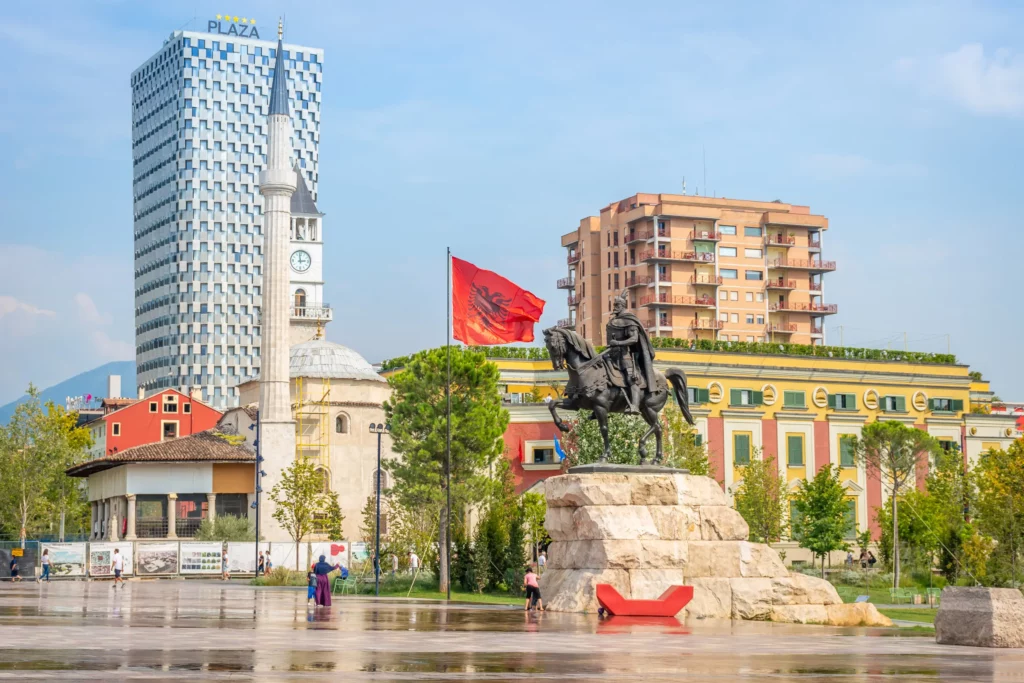
Arriving in Tirana, the vibrant capital of Albania, you’ll step into a city that has evolved from a 17th-century Turkish outpost to a colorful, fast-developing metropolis.
Start your journey at Skanderbeg Square, the city’s beating heart. Take in the statue of Skanderbeg, the national hero, and the Ottoman-era architecture of the Et’hem Bey Mosque. Make sure to appreciate the 30,000 multi-colored tiles arranged in traditional Albanian carpet patterns. Roaming the square is free, but expect to pay about 200 lek ($1.75) to enter the mosque.
Next, explore the National History Museum, which provides a comprehensive overview of Albania’s history from antiquity to the present day. The entry fee is around 200 lek ($1.75).
Art enthusiasts should visit the National Gallery of Arts, showcasing Albanian artworks from the 19th and 20th centuries for an entry fee of about 200 lek (~$1.75).
Complete your historical journey at Bunk’Art, a nuclear bunker from the communist era turned into a museum. A powerful testament to Albania’s past, entry will cost you 500 lek ($4.50).

Tirana’s food scene is a delight. Indulge in local dishes like ‘tavë kosi’ and ‘baklava’. Expect to pay between 400-700 lek ($3.50-$6) for a delicious meal.
Tirana’s nightlife is lively and energetic. Try out Hemingway Bar, known for its creative cocktails, with prices around 500 lek ($4.50) per drink. I had such a great time there, nothing but good vibes!
Day 5 to Day 7
For the outdoor adventurers, take the Dajti Ekspres Cable Car up to Dajti Mountain for around 800 lek ($7) for a round trip. There you can explore hiking trails, picnic spots, and even try paragliding.
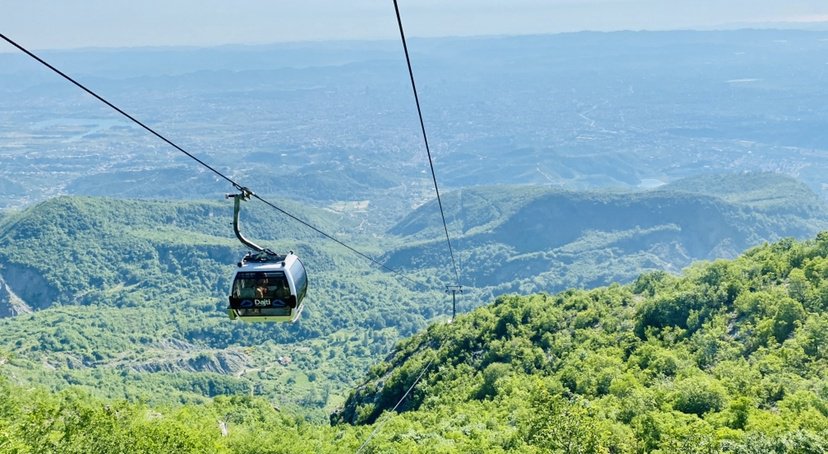
Finally, unwind at the Grand Park of Tirana. It’s free to enter, and you can rent a bike or paddle around the artificial lake.
As for transportation, Tirana is a walkable city. Public buses and taxis are readily available for longer journeys, with taxi rides generally affordable, especially for short distances within the city center.
After immersing yourself in the vibrancy of Tirana, with its rich history, arts, food, and outdoor activities, you’ll be well-prepared to embark on the rest of your journey across this fascinating country.
Week 2: The Southern Coast
Day 8 to Day 14
Upon departing from Tirana, the second leg of your journey escorts you to the southern coast of Albania, where the captivating towns of Saranda and Vlora await. Known for their stunning beaches, rich historical sites, and outdoor adventures, this portion of the Albanian Riviera is sure to enchant you.
Saranda:
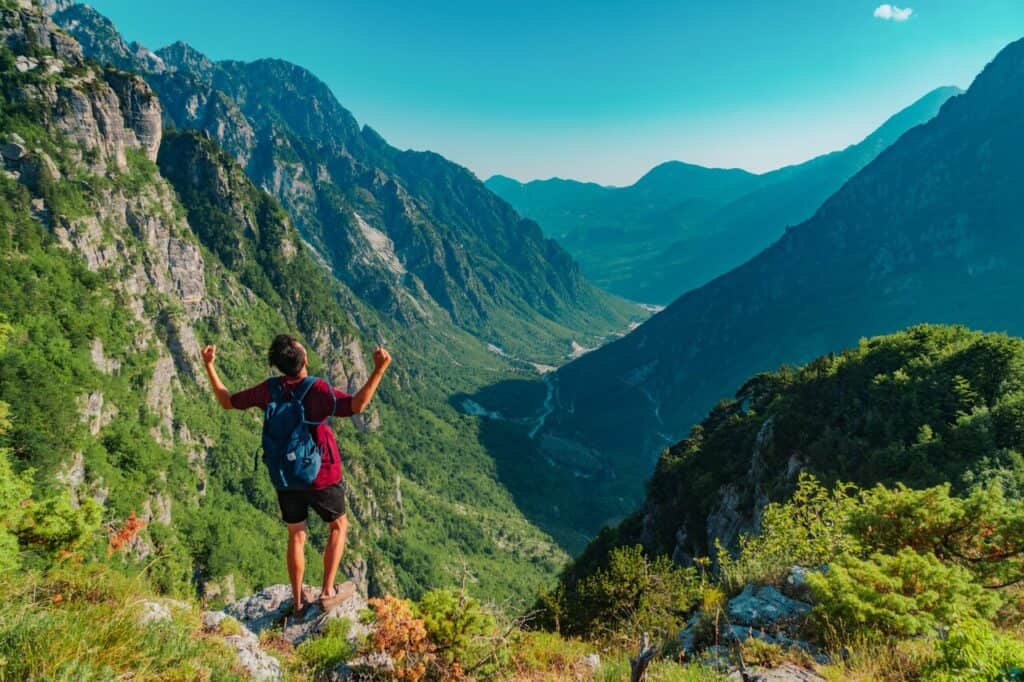
Saranda is a picturesque seaside town at the southernmost edge of the country. Also known as,”Pearl of the Balkans” because of its bright blue waters and beautiful beaches. Mirror Beach is a must-visit for sunbathing and relaxing. While you can bask in the sun for free, a sunbed will cost you around 500 lek ($4.50). The town’s seafront is perfect for evening strolls, lined with cafes and restaurants offering delicious seafood – expect to pay around 1500 lek ($13) for a meal.
Just a short trip away from Saranda, the ancient city of Butrint is a treasure trove of history. As a UNESCO World Heritage Site, Butrint is home to well-preserved Roman ruins, including a theatre, baths, and basilica, all set within a lush natural park. The park’s entrance fee is around 700 lek ($6), and guided tours are available for a deeper dive into the area’s history.
Vlora
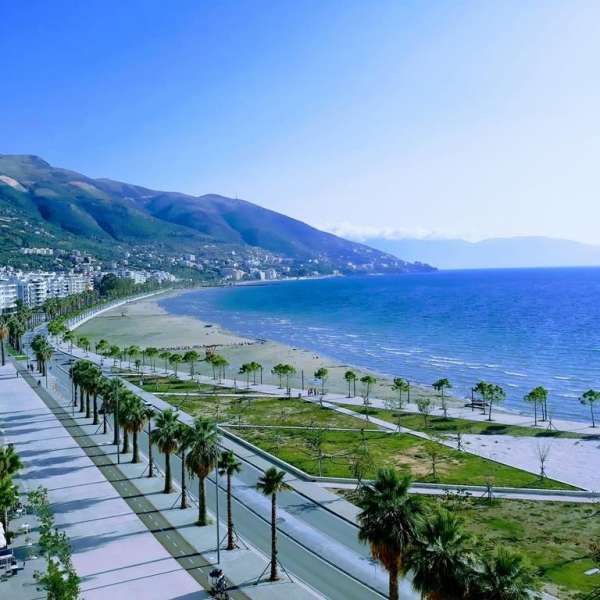
Traveling north, you’ll encounter Vlora, a city where the sea meets the mountains. The city’s massive beach is an ideal spot for relaxation or swimming. Pay a visit to the Independence Monument, which commemorates Albania’s declaration of independence in 1912 – entry to the museum is about 200 lek ($1.75). For some good eats, consider trying ‘çorba,’ a local fish soup, at one of the seafront restaurants – a meal usually costs between 700-1000 lek ($6-$9).
In addition to its beautiful beaches, Vlora serves as the gateway to the Llogara National Park. For outdoor enthusiasts, this is the perfect place for hiking, bird-watching, or even paragliding. Entry to the park is free, but for a more informative experience, consider hiring a guide at around 4000-5000 lek ($35-$44). The park is also home to a range of accommodation options, including camping sites and mountain lodges.
Gjirokaster

If time permits, a side trip to the historical city of Gjirokaster is well worth it. Famed as the ‘City of Stone,’ Gjirokaster’s unique Ottoman-era architecture and hilltop fortress offer a fascinating peek into the past. The fortress’s entry fee is 200 lek ($1.75), and provides stunning panoramic views of the city and the surrounding valley. While there, be sure to check out the Ethnographic Museum, former home of Albanian dictator Enver Hoxha, to get a glimpse of traditional Albanian life. The entrance fee is 200 lek ($1.75).
When it comes to transportation, Saranda and Vlora are well-connected by buses and furgons (minibuses). The journey from Saranda to Vlora by bus will cost about 1000 lek ($9), and the travel time is approximately 4-5 hours. Furgons offer a more flexible schedule but tend to be slightly more expensive.
Week 3: The Albanian Alps
Days 15-21

Alright, let’s crank up the altitude and delve into the raw, untamed wilderness of the Albanian Alps, an edgy mountain range that doesn’t play by the rules.
Albanian Alps
This isn’t your cookie-cutter mountain range. The Albanian Alps are a rollercoaster of craggy peaks, deep valleys, and diverse wildlife. Wolves, bears, lynxes, oh my! They’ve got ’em all. And let’s not forget the hundreds of bird species that call these mountains home. A day here feels like you’ve stepped into a David Attenborough documentary. Just remember, it’s their house, and we’re just visiting.
Hiking
The Valbona to Theth hike is the mountain’s best shot at breaking you. It’s a marathon, not a sprint – we’re talking 6-8 hours of rocky paths, dramatic vistas, and sheer determination. The payoff? Some of the best views in the whole country. Doing it solo is free, but if you prefer company, you can get a local guide to tag along for around 5000 lek ($44). A fair price to avoid getting lost in the wilderness, don’t you think? We did it without but definitely wouldn’t hurt to have a guide.
Traditional Guesthouses and Local Customs
When the day’s done and your legs are screaming for mercy, flop down in one of the traditional guesthouses. For 3000-4000 lek ($26-$35) per night, you get a cozy bed, home-cooked meals, and a crash course in local culture. Ever heard of ‘raki?’ This fiery local spirit is the highlander’s answer to a fun evening. It’s an acquired taste, but when in the Alps, right?
Getting There and Around

Getting to the Alps is half the fun. Hop on a ferry across the awe-inspiring Koman Lake for around 1000 lek ($9). It’s a journey that’ll have your phone memory crying for mercy. Once you’ve landed in the Alps, minibuses and taxis are the way to go. They’ll zip you between mountain towns pretty fast.
Now that you’ve faced the ‘Accursed Mountains’ and lived to tell the tale, it’s time to regroup and get ready for the final week of your grand Albanian adventure
Week 4: Cultural Immersion in Berat and Krujë
Days 22-28
Alright, it’s time to wrap up this epic road trip in style. We’re heading to Berat and Krujë, two cultural heavyweights that’ll give you a real taste of Albanian life. Ready to get your mind blown? Let’s hit it.
Berat
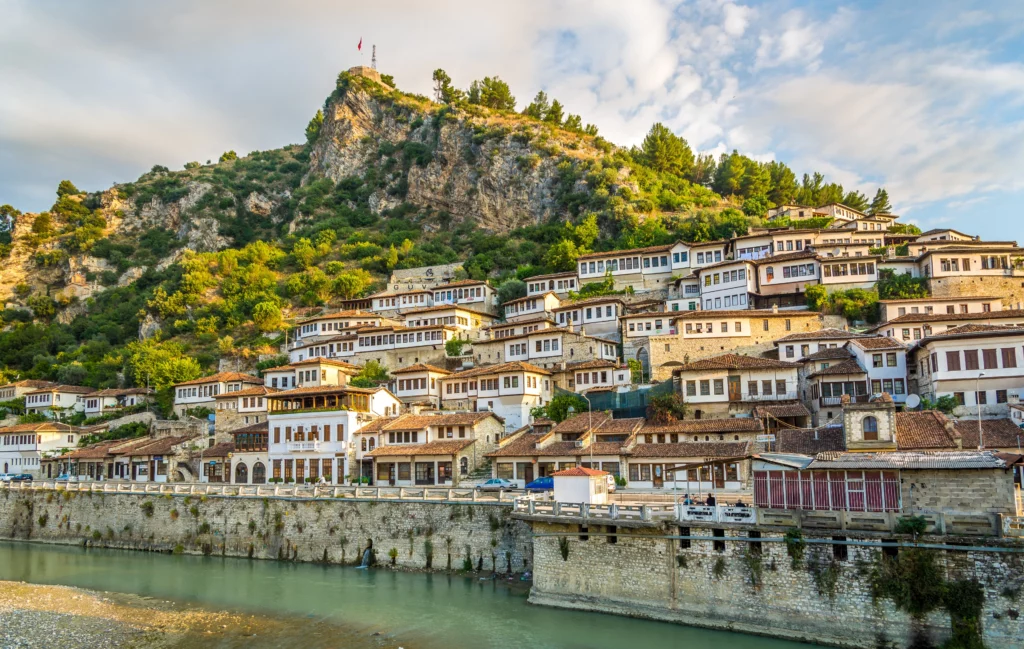
This is no ordinary city. Berat, aka the “city of a thousand windows”, is an artist’s dream come true. The city’s white Ottoman houses climbing up the hill towards the castle, their windows gazing out over the Osum River, will have your camera begging for mercy. The entrance to the Berat Castle is a bargain at just 200 lek ($1.75). While you’re there, slip into the Onufri Iconography Museum inside the castle grounds, with its legendary icon paintings. It’ll set you back another 700 lek ($6), but it’s worth every penny.
Krujë

Next up, we’re hitting Krujë, a town that punches way above its weight. At the top of the list is the Skanderbeg Museum, dedicated to the national hero who gave the Ottomans a hard time. The entrance fee is 700 lek ($6), and it’s worth every cent. Just next door, you’ve got the Krujë Castle, which offers spectacular views over the town and beyond.
After getting your historical fix, stroll through the Old Bazaar. This isn’t your average market. We’re talking centuries-old shops selling everything from traditional ‘qilim’ rugs to handcrafted copper coffee pots. Don’t be shy to haggle a bit – it’s part of the fun!
Culinary Traditions
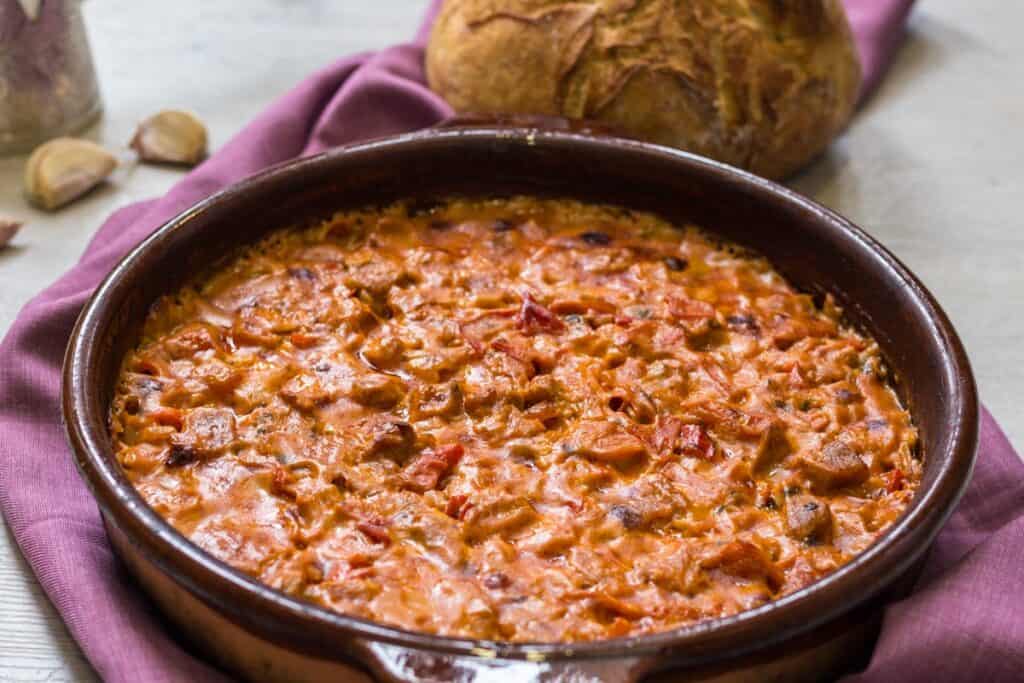
After all that walking, you’ll be starving. Both Berat and Krujë offer up some delicious local dishes. Try the ‘fërgesë’, a scrumptious blend of peppers, tomatoes, and cottage cheese. Expect to pay about 500-1000 lek ($4-$9) for a hearty meal.
Transport
Getting to Berat from Tirana is straightforward. Regular buses run the route, costing around 300 lek ($2.60) and taking about two hours. For Krujë, it’s even easier – minibuses depart from Tirana’s North Bus Station every 30 minutes, costing around 200 lek ($1.75).
Inside the cities, your best bet is your own two feet. Most attractions are within walking distance, and the chance to wander through Berat and Krujë’s atmospheric streets is too good to pass up.
Well, that’s it. You’ve trekked through the mountains, lounged on the beach, dove into the culture, and ate enough ‘byrek’ to last a lifetime. But as we say in Albania, ‘Tungjatjeta’ – long life to you.
Revelling in Albania’s Festivities and Traditions
Days 29-30:
Spend the final stretch of your journey indulging in Albania’s vibrant culture, rhythmic music, and mouth-watering cuisine. Here’s what’s in store!
Jazz Festival
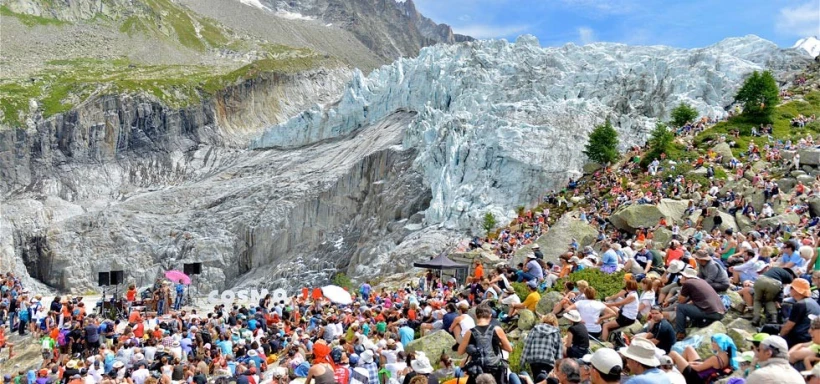
Often held in Tirana at the Rinia Park or the Pyramid, the Jazz Festival is a prime event showcasing the country’s musical landscape. Both local and international artists take the stage, engulfing the city in captivating melodies. Entry is typically free, but some exclusive performances might require tickets, generally priced around 1000-2000 lek ($9-$18). Public buses and taxis offer easy accessibility within Tirana.
Other Festivals
The Summer Festival in Berat is a visual and cultural treat, typically held in July. You can reach Berat by bus from Tirana, which costs around 500 lek ($4.50) and takes about 2-3 hours. Similarly, Gjirokaster, reachable via a 3-hour bus ride costing 700-800 lek ($6-$7) from Tirana, hosts the Folklore Festival every five years. It’s a grand spectacle of Albanian culture with music, dance, and costumes.
Traditional Music and Dance
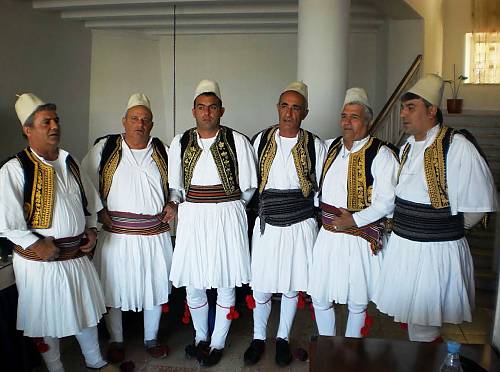
Delve deeper into the local culture by experiencing the mesmerizing Iso-polyphony, a music tradition often performed in the southern part of the country. Check out local bars or cultural centers in Tirana or Berat for live performances. Many restaurants also host traditional dance performances where you can join in and learn a step or two!
Local Cuisine
Street food vendors in the heart of Tirana or other major cities often sell ‘byrek,’ a quintessential Albanian savory pastry. One piece generally costs around 100 lek ($0.90). And, of course, there’s the infamous ‘raki,’ Albania’s potent local brandy, available almost everywhere but often enjoyed in local bars.
Customs and Traditions
During your travels across the country, you’ll witness first-hand the Albanian customs of honoring elders, showing hospitality to guests, and taking pride in their heritage. When visiting religious sites, modest dress is required, with women needing to cover their heads in mosques. These are often free to enter but may ask for a small donation.
In a nutshell
Your month-long backpacking trip is an exploration through a land that, despite its humble size, is packed with mesmerizing landscapes, historic treasures, friendly locals, and a culture steeped in stories of its resilient past.
A word to all you future travelers: this itinerary provides just a taste of what Albania has to offer. Each town, each trail, each person, and each meal here has a story to share. So get ready, pack your bags, lace up your boots, and let Albania’s surprises unravel. Remember, the road is the best storyteller there is. Check out our guide on where to travel next if your’e ready to take on your next adventure!

